Indonesian snack foods showcase a diverse fusion of flavors and textures, embodying the country's rich culinary traditions. Crispy, savory bites and sweet pastries crafted with unique local ingredients are popular choices. The snacking culture often features delightful combinations of spices, offering a balance between sweet and savory. Street vendors contribute to the culinary tapestry with inventive, convenient options for on-the-go indulgence. The array of Indonesian snacks captures the essence of the vibrant and indulging nature of Indonesian cuisine.
Satay

Satay is a popular snack food that consists of skewered and grilled meat, traditionally made from chicken, beef, or pork, although variations with lamb, goat, or even seafood can be found. The meat is marinated in a flavorful blend of spices, such as turmeric, coriander, and lemongrass, which gives it a unique and aromatic taste. Satay is typically served with a side of peanut sauce, which adds a nutty and slightly sweet flavor to the dish. This sauce is made from ground peanuts, coconut milk, and a combination of spices, including garlic, chili, and tamarind. The skewered meat is grilled over an open flame, resulting in a smoky and charred flavor that complements the tender and juicy meat. Satay is often served with a side of rice, cucumber slices, and sometimes a small portion of lontong (rice cakes).
Murtabak
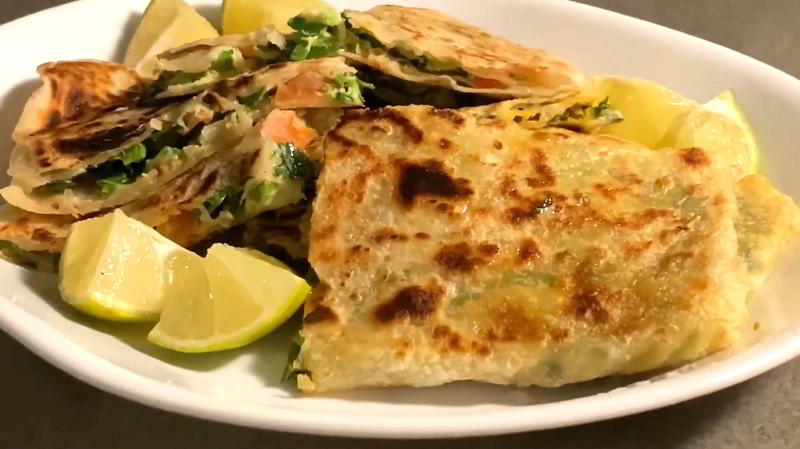
Murtabak is a dish that combines elements of a stuffed pancake and a savory pastry. The name "murtabak" is believed to have originated from an Arabic word meaning "folded." The dish typically consists of a thin and crispy outer layer made from flour and eggs, which is then folded over a flavorful filling. The filling can vary, but common options include minced meat (such as beef or chicken), onions, eggs, and spices. Some variations also include vegetables or cheese. Murtabak is traditionally cooked on a griddle or flat pan, which gives it a crispy texture on the outside while keeping the filling moist and flavorful. It is often served with a tangy dipping sauce, such as chili sauce or pickled vegetables, to complement the rich flavors. This snack food is a favorite among Indonesians for its savory taste and versatility. It can be enjoyed as a quick street food snack or as a more substantial meal. Murtabak is often found at food stalls or street vendors, where it is freshly made and served piping hot. Its combination of crispy, savory, and fragrant flavors makes it a delightful treat for any snack lover.
Prawn Cracker
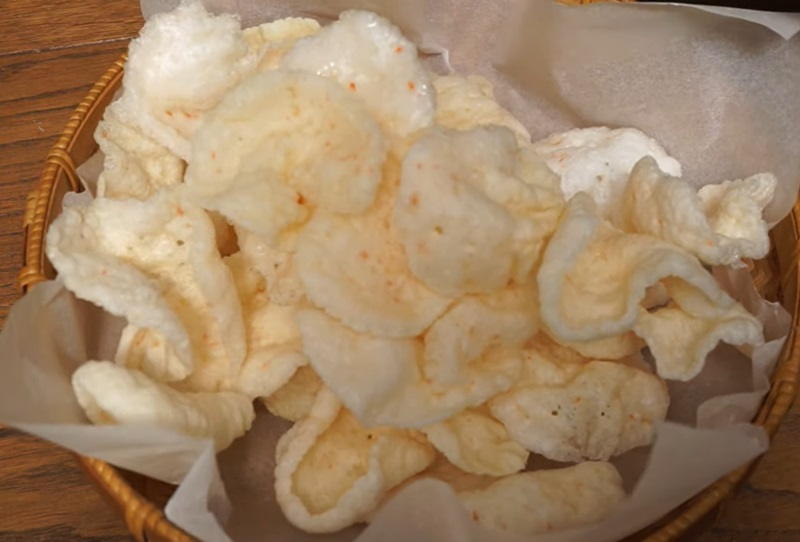
Prawn cracker, known as krupuk udang in Indonesia, is a popular snack that is loved by many people across the country. These crispy and flavorful crackers are made from a mixture of prawn or shrimp, tapioca flour, and various seasonings. The process of making prawn crackers involves grinding the prawns into a paste, mixing it with tapioca flour and other ingredients, and then shaping and drying the mixture. Once dried, the cracker mixture is deep-fried until it puffs up and turns golden brown. The result is a light and crispy snack with a distinct shrimp flavor. Prawn crackers are commonly enjoyed on their own as a quick and tasty snack, but they are also often served as an accompaniment to main dishes or as a topping for soups. Prawn crackers are available in various shapes and sizes, ranging from small bite-sized pieces to larger, flat sheets. They come in a wide variety of flavors, with some being spicier or more savory than others. Whether enjoyed as a snack on a lazy afternoon or as a crunchy addition to a meal, prawn crackers are a beloved Indonesian treat that is sure to satisfy any craving.
Bibingka
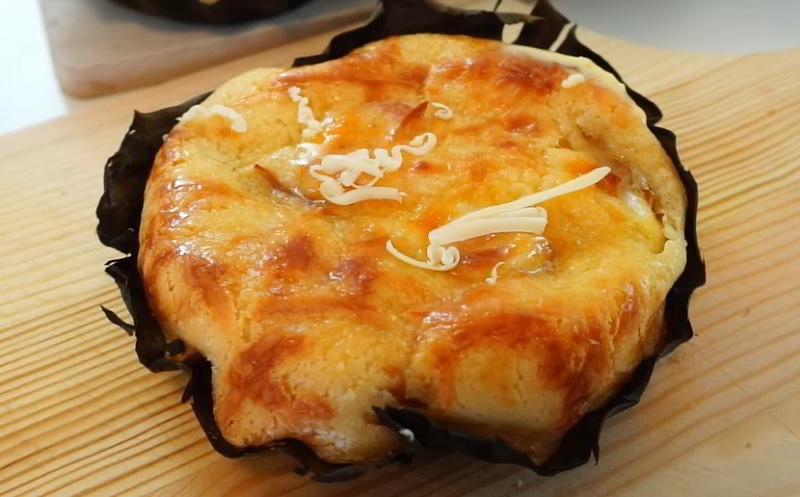
Bibingka is a delectable creation that blends rice flour, coconut milk, eggs, sugar, and occasionally pandan leaves for an extra burst of flavor. Traditionally cooked in small clay pots, this method imparts a unique and authentic taste to the dish. To craft bibingka, the batter is poured into clay pots and baked in a charcoal oven, resulting in a slightly crispy and golden exterior. Served warm, it is often adorned with grated coconut or a drizzle of sweet syrup. The taste is a harmonious blend of sweetness from sugar and richness from coconut milk, delivering a soft and chewy texture that is immensely satisfying. The fragrant aroma of pandan leaves enhances the overall experience. Bibingka is a versatile treat enjoyed as a snack or dessert, commonly found in local markets and street food stalls. Its simplicity and deliciousness make it a cherished delight, guaranteed to please any sweet tooth with its unique blend of flavors and textures.
Poffertjes
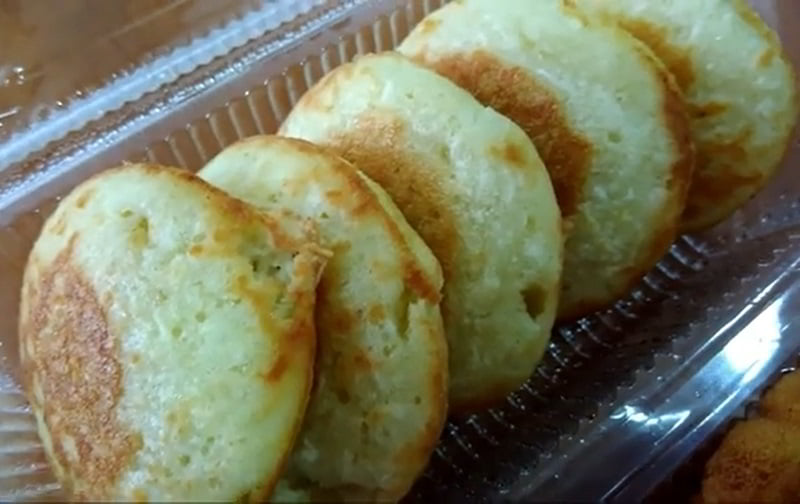
Poffertjes are small, fluffy, and delicious bite-sized pancakes that are typically made from a batter consisting of flour, yeast, and milk. Poffertjes have a distinctive round shape and are cooked on a special griddle with multiple small round molds. This unique cooking technique ensures that each poffertje is evenly cooked and has a soft and spongy texture. Poffertjes are often served in generous portions, topped with a variety of toppings and condiments. Traditional toppings include powdered sugar, butter, and a drizzle of honey or syrup. However, modern variations have emerged, with toppings such as chocolate sauce, fruit compote, whipped cream, and even savory options like cheese and bacon. These delectable treats are commonly enjoyed as a snack or dessert and are often found at street food stalls, markets, and festivals in Indonesia. Poffertjes are loved by people of all ages and are a favorite indulgence during special occasions or simply as a sweet treat to satisfy cravings.
Krupuk

Krupuk is a type of deep-fried cracker made from various ingredients such as shrimp, fish, rice, or vegetables. The process of making Krupuk involves grinding the main ingredient into a paste, mixing it with other flavorings and spices, and shaping it into thin, flat pieces before frying them until they become crispy and golden. Krupuk comes in a wide range of flavors and textures, offering a delightful culinary experience. Shrimp and fish-based Krupuk are rich in umami flavors, while rice-based ones have a light and crispy texture. Vegetable-based Krupuk, such as those made from cassava or taro, offer a unique taste and texture. In Indonesia, Krupuk is commonly enjoyed as a snack on its own, but it is also often served as a condiment alongside main dishes. It adds a satisfying crunch and enhances the flavors of soups, stews, and stir-fried dishes. Krupuk is widely available in local markets, street food stalls, and supermarkets, making it easily accessible for everyone to enjoy.
Dodol
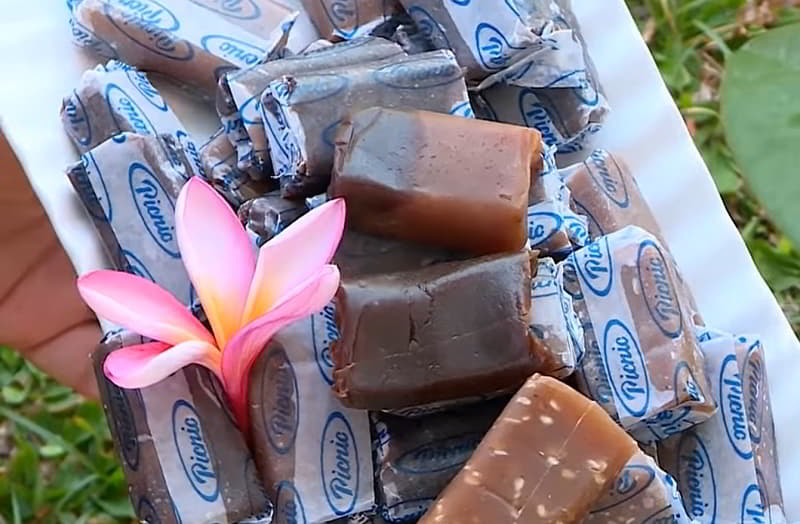
Dodol is a sticky and chewy treat made primarily from coconut milk, palm sugar, and glutinous rice flour. Dodol comes in various flavors such as pandan, durian, chocolate, and peanut, catering to different taste preferences. The process of making dodol is labor-intensive and time-consuming. The ingredients are cooked and stirred continuously for hours until the mixture thickens and reaches the desired texture. Dodol is then poured into molds or banana leaves and left to cool and set. The result is a delightful treat with a unique texture that is both chewy and sticky. Dodol has a rich and sweet flavor, with a hint of caramel from the palm sugar. It is often enjoyed as a snack or dessert, especially during festive occasions and celebrations. Dodol is not only delicious but also a cultural symbol in Indonesia. It is often given as a gift or souvenir, representing warmth, hospitality, and togetherness.
Apam Balik
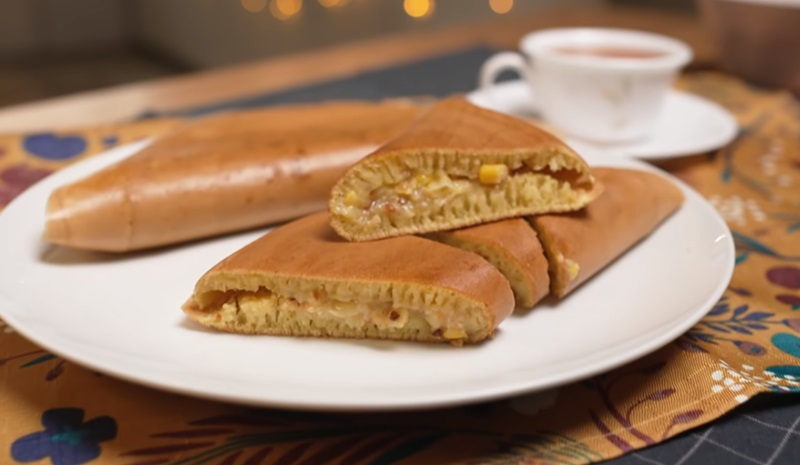
Apam balik is a type of pancake that is typically filled with a sweet mixture of crushed peanuts, sugar, and sometimes corn. The pancake itself is made from a batter that is made with flour, eggs, sugar, and coconut milk, giving it a slightly sweet and fragrant taste. The preparation of apam balik starts with pouring the batter onto a greased griddle or pan, and spreading it out into a thin, round shape. Once the pancake starts to cook, the peanut filling is added to one side, and the pancake is folded in half, creating a semi-circular shape. It is then cooked until golden brown and crispy on the outside. Apam balik is often enjoyed as a snack or dessert, and it is commonly sold by street vendors or in local markets. The combination of the soft and fluffy pancake with the crunchy and sweet peanut filling creates a delightful texture and flavor contrast. It is a beloved treat that is perfect for satisfying cravings for something indulgent and delicious.
Pandan Cake
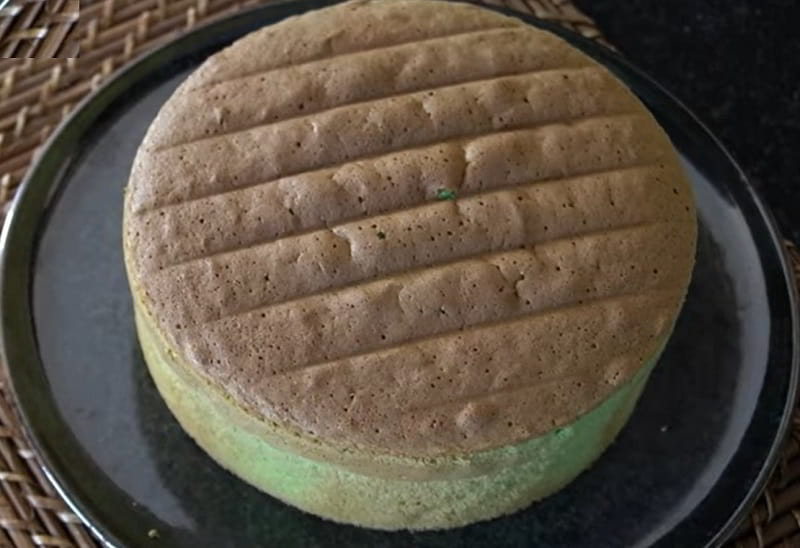
Pandan cake is a popular sponge cake known for its vibrant green color and fragrant pandan flavor. This delectable dish is made from a mixture of pandan juice, flour, sugar, eggs, and coconut milk. The pandan juice is obtained by blending the pandan leaves with water and extracting its essence. The pandan cake has a light and fluffy texture, similar to a sponge cake, and is often enjoyed with a cup of tea or coffee. It is commonly seen in Indonesian households and bakeries and as a treat during special occasions or festivals. The distinctive green hue of the pandan cake is derived solely from the natural pandan leaves, without the use of artificial food colorings. The fragrant aroma of the pandan adds a unique and refreshing flavor to the cake, making it a delightful and memorable snack. Pandan cake is also a versatile dish, as it can be served on its own or accompanied by various toppings such as shredded coconut, chocolate drizzle, or a dusting of powdered sugar. Its soft and airy texture makes it an irresistible treat for those with a sweet tooth.
Banana Chips
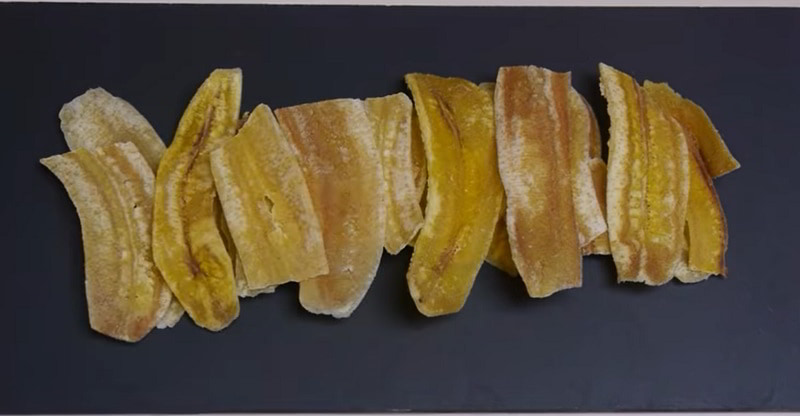
Banana chips, known as keripik pisang locally, hold a beloved status as a popular snack in Indonesia. Crafted from thinly sliced bananas, these chips undergo deep-frying until achieving a crispy, golden-brown perfection. The process begins by selecting ripe yet firm bananas, which are peeled and sliced into thin rounds. These slices are then immersed in hot oil, transforming into delightfully crispy and crunchy banana chips with a sweet and subtly tangy flavor. Enjoyable on their own as a quick and tasty snack, banana chips also serve as versatile toppings for desserts like ice cream or yogurt. Beyond their deliciousness, banana chips offer various health benefits, given bananas' richness in potassium, dietary fiber, and vitamins. This makes banana chips a healthier alternative to traditional potato chips, being gluten-free and suitable for individuals with gluten intolerances or dietary restrictions.
Lontong
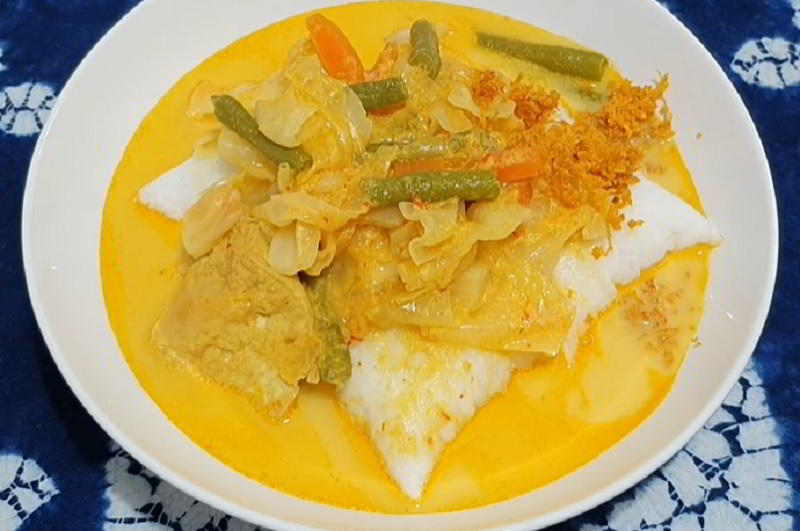
Lontong is a popular dish that consists of compressed rice cake, typically wrapped in banana leaves and then boiled until the rice becomes firm and compact. It is often served as a staple alongside various Indonesian dishes, such as soto (soup), rendang (spicy beef stew), or sayur lodeh (vegetable curry). The rice cakes are cut into slices before serving, and they provide a base for absorbing the flavors of accompanying dishes. Longtong is valued for its ability to complement and balance the rich and spicy flavors commonly found in Indonesian cuisine. Overall, longtong is a versatile and beloved component of Indonesian cuisine, appreciated for its texture, ability to absorb flavors, and its role in making meals more filling and satisfying.
Curry Puff
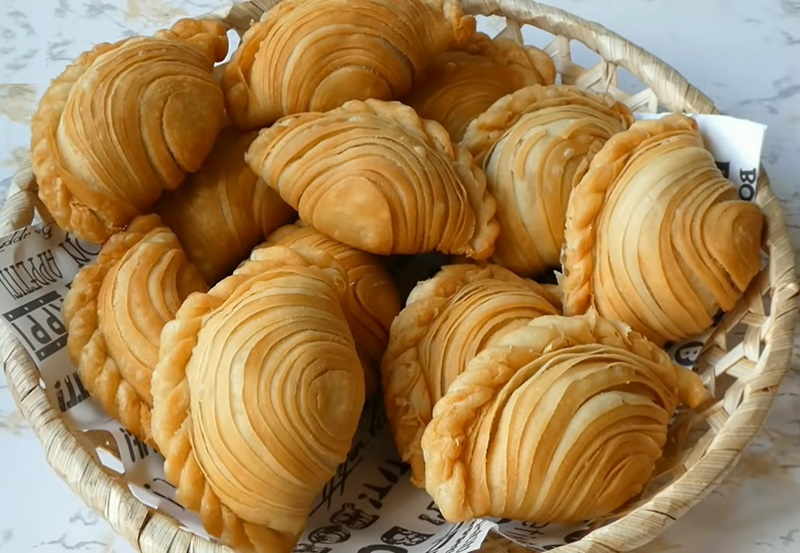
Curry puff, also known as Kue pastel, is a savory dish that typically consists of a crispy pastry shell filled with a mixture of cooked vegetables, meat, and aromatic spices. The pastry shell is made from a thin layer of dough that is rolled out and then folded over the filling to create a pocket. It is then deep-fried until golden brown and crispy on the outside, while the inside remains moist and flavorful. The filling is usually made with a combination of potatoes, carrots, onions, and minced meat such as chicken or beef. Curry puffs are often enjoyed as a snack or appetizer, and they can be found in street food stalls, markets, and even some restaurants. They are perfect for on-the-go eating and are often served with a side of chili sauce or ketchup for dipping.
Otak-otak

Otak-otak is a traditional dish that originates from Palembang, South Sumatra, and has gained popularity throughout the country due to its unique flavors and delightful taste. Otak-otak is made from a mixture of fish meat, spices, coconut milk, and tapioca flour. The ingredients are blended together to create a smooth paste, which is then wrapped in banana leaves and grilled over charcoal. This cooking method not only enhances the flavors but also gives a smoky aroma to the dish. The end result is a mouthwatering snack that is both soft and slightly chewy in texture. The combination of spices and coconut milk gives otak-otak a rich and savory taste, with a hint of sweetness. Some variations of otak-otak also include additional ingredients such as prawns, squid, or even chicken. This snack is best enjoyed with a side of spicy peanut sauce or chili sauce, adding an extra kick to the already flavorful dish. Whether it is enjoyed as a quick snack or as part of a meal, otak-otak is a must-try Indonesian delicacy that will leave you craving more.
Bakpia
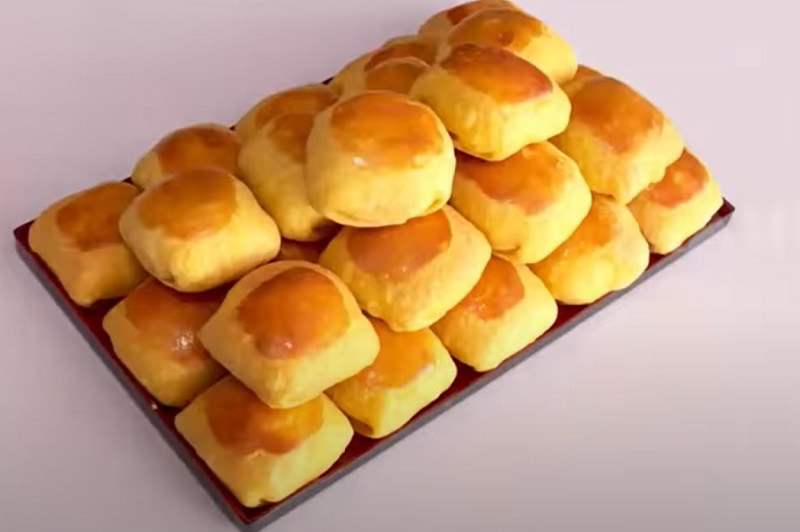
Bakpia, also known as Bakpia pathuk, is a small, round-shaped pastry filled with various sweet fillings, typically made from mung bean or green bean paste, although there are also other variations like chocolate, cheese, and even durian. The outer layer of bakpia is made from a thin, flaky pastry dough that is slightly sweet and has a light, crispy texture when baked. The filling is usually cooked and mashed beans that have been sweetened with sugar and flavored with vanilla or other aromatic spices. The combination of the delicate pastry and the sweet, creamy filling creates a delightful burst of flavor in every bite. Bakpia is commonly enjoyed as a snack or souvenir, and it is often served with a cup of hot tea or coffee. It is also a popular gift to bring back from Yogyakarta for friends and family. The small size and individual packaging of bakpia make it convenient for snacking on the go or sharing with others.
Klepon
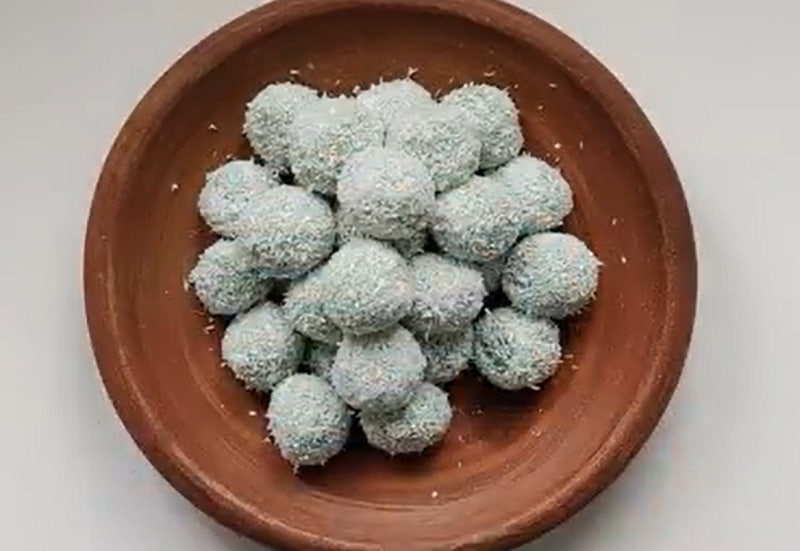
Klepon is a delicious dish made from glutinous rice flour filled with a sweet surprise in the center. The filling is typically made from palm sugar, which adds a delightful burst of sweetness when you take a bite. The dough is made by combining glutinous rice flour with water, creating a soft and sticky texture. It is then shaped into small balls and flattened slightly. The palm sugar filling is then added to the center, and the dough is carefully sealed to ensure that the filling stays intact. Once the klepon is assembled, it is boiled in a pot of boiling water until it becomes tender and chewy. The final step is rolling the klepon in grated coconut, which adds a hint of nutty flavor and an extra layer of texture. When you bite into a klepon, you are greeted with a sticky and chewy outer layer, followed by a burst of sweet palm sugar in the center. This delightful combination of flavors and textures makes klepon a favorite snack among Indonesians.
Emping
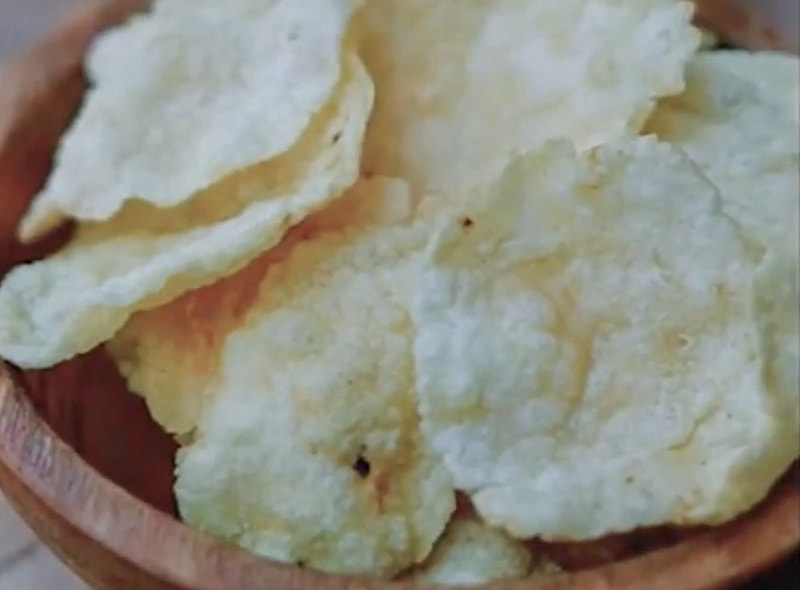
Emping, a beloved snack crafted from melinjo nuts, undergoes a meticulous process to reach its delightful form. Beginning with boiling, and then meticulous peeling and mashing, the nuts transform into a smooth, dough-like texture. This pliable mixture is then shaped into thin, circular discs, either sun-dried or deep-fried until achieving a crispy, golden-brown perfection. The resulting emping boasts a unique flavor profile, with a subtle nuttiness complemented by a hint of bitterness. Enjoyed both on its own and as a versatile topping, emping adds texture and flavor to various dishes. Moreover, beyond its gastronomic appeal, emping offers notable health benefits. Melinjo nuts, rich in fiber, make emping a nutritious alternative to many other snacks. This combination of delightful taste and nutritional value has contributed to emping's enduring popularity, captivating palates all across the globe.
Banana Fritter
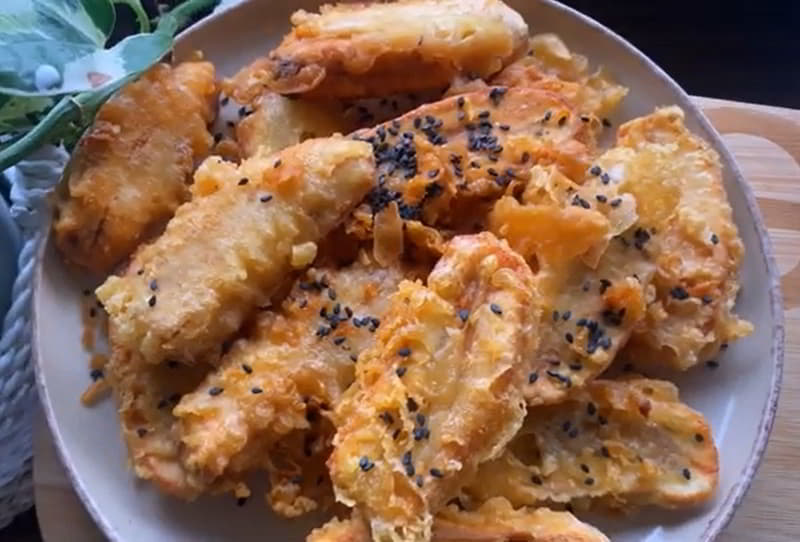
Banana fritters, or pisang goreng, are a delightful treat that involves coating ripe bananas in a batter made from flour, sugar, and water, followed by deep-frying to achieve a crispy perfection that harmonizes sweet and savory flavors. Typically consumed as a snack or dessert, banana fritters are commonly sold by street vendors across Indonesia, each vendor often infusing their own unique twists into the recipe. Served piping hot, these fritters come in various sizes and shapes, showcasing the creativity of vendors. The crispy outer layer contrasts appealingly with the soft, sweet banana inside. The natural sweetness is further enhanced by the caramelization during frying, resulting in a deliciously sweet treat. Some variations may include additional ingredients like cheese, chocolate, or jackfruit for added flavor and texture. Whether enjoyed solo or paired with hot tea or coffee, banana fritters cater to any sweet tooth.
Spekkoek
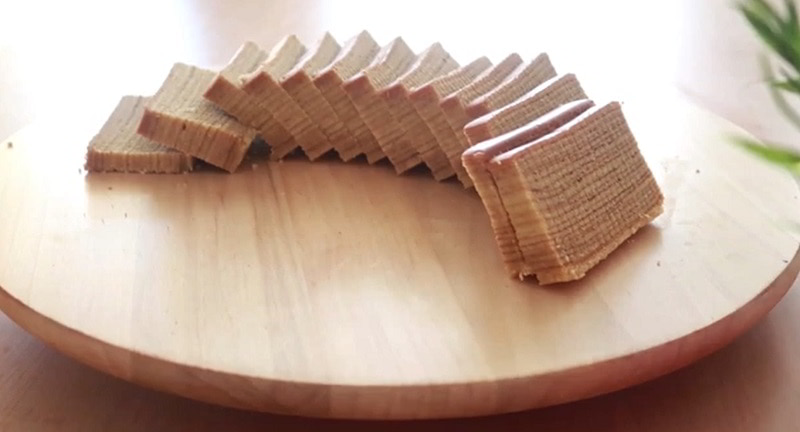
Spekkoek, also known as lapis legit, is a layered cake made with a unique combination of spices, flour, butter, and eggs. It is a labor-intensive dish that requires patience and skill to master. The name "spekkoek" translates to "bacon belly" in English, referring to the alternating layers of light and dark colors, resembling bacon strips. The cake is typically baked layer by layer, with each layer being cooked before adding the next one. This process results in a cake with up to 18 layers, each one adding a distinct taste and texture. Spekkoek is rich, moist, and has a complex flavor profile. The spices used in its preparation include cinnamon, cardamom, nutmeg, and cloves, which infuse the cake with warm and aromatic notes. The texture is dense yet soft, with a slightly caramelized exterior. This delightful Indonesian treat is often served during festive occasions, such as birthdays and holidays. It is enjoyed as a sweet snack or dessert, complemented by a cup of tea or coffee.
Tapai
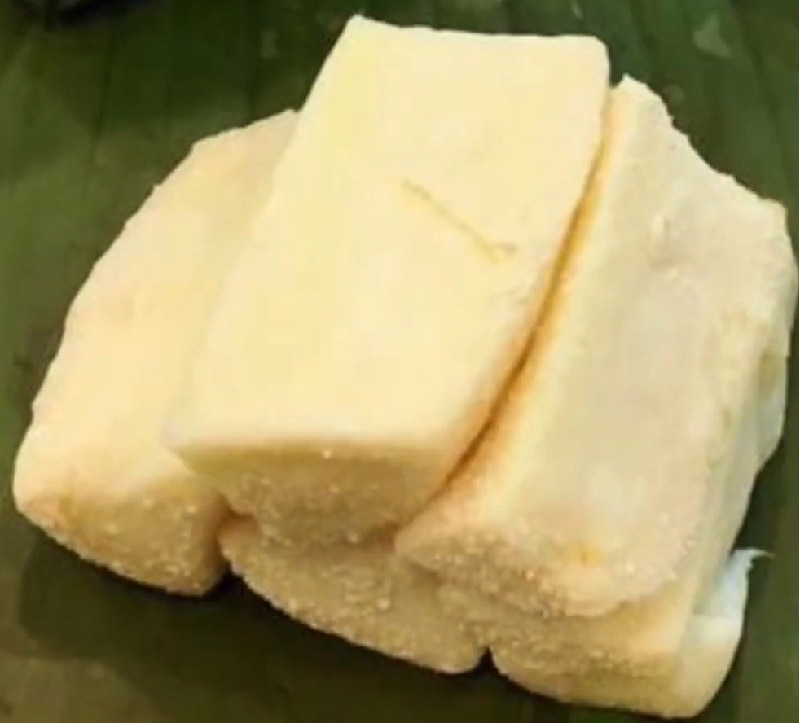
Tapai is a traditional snack made from fermented rice or cassava, giving it a unique and tangy flavor. It is typically enjoyed as a snack or dessert and is known for its soft and chewy texture. The process of making tapai involves soaking the rice or cassava in water and then allowing it to ferment for several days. The longer the fermentation process, the stronger the flavor of the tapai. Tapai can be enjoyed on its own or used as an ingredient in various dishes. It is often used in traditional Indonesian dishes and desserts. Some people even use tapai as a filling for cakes or pastries to add a unique twist to their creations. With its tangy and slightly sweet taste, tapai is a favorite snack among Indonesians. Its unique flavor and chewy texture make it a delightful treat that is perfect for any occasion.
Kue
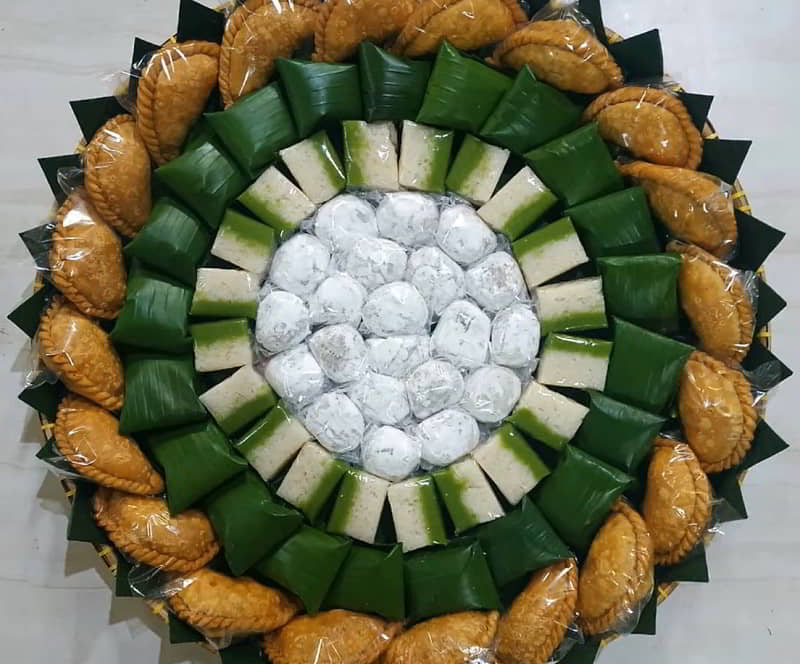
Kue is a bite-sized snack made from a variety of ingredients such as rice flour, coconut milk, sugar, and various flavorings. Kue comes in a wide range of shapes, colors, and flavors, making them visually appealing and delicious. One of the most common types of Kue is Kue Lapis, a layered cake made with alternating layers of colorful rice flour batter and coconut milk. Another popular variety is Kue Dadar, which is filled with sweet coconut and palm sugar. Kue Klepon is another favorite, featuring a chewy rice flour exterior filled with liquid palm sugar and coated with grated coconut. These snacks are commonly enjoyed as a sweet treat during tea time or as a dessert after meals. They are often homemade, with families passing down traditional recipes from generation to generation. Kue can also be found in local markets and street stalls throughout Indonesia, where they are freshly made and sold in small, bite-sized portions. With its unique flavors and textures, Kue provides a delightful taste of Indonesian culinary culture and is a must-try for anyone seeking a sweet and savory adventure.
Kue Lapis
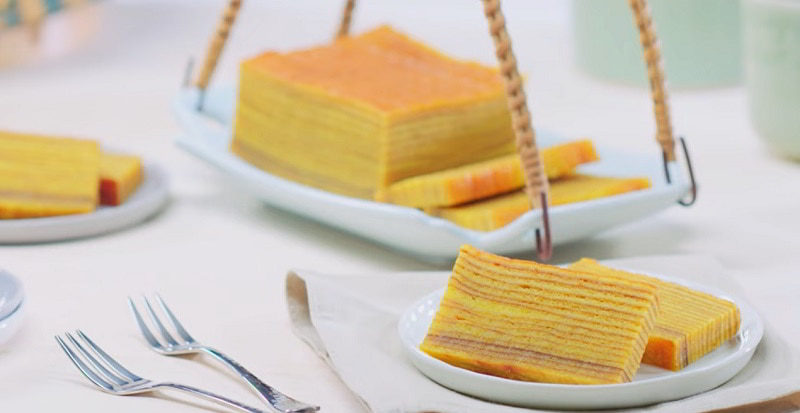
Kue lapis, also recognized as a layered cake, stands out as a popular and delightful Indonesian snack, both visually enticing and delicious. This traditional treat boasts layers of colorful, fragrant cake, each offering a distinct flavor. Crafted from a blend of rice flour, coconut milk, sugar, and flavorings like pandan or chocolate, the batter is poured into a square or rectangular pan and steamed until set to create each unique layer. The layering process is repeated until achieving the desired number, resulting in a stunning multicolored cake with a soft, slightly chewy texture. Frequently savored as a snack or dessert, kue lapis is a common feature during special occasions and celebrations, making it a popular gift during festive seasons. Its unique amalgamation of flavors and textures has earned its favor among both locals and tourists. Whether enjoyed alongside a cup of tea or as a standalone sweet indulgence, kue lapis remains a delightful Indonesian snack guaranteed to satiate your cravings.
Kue Putu
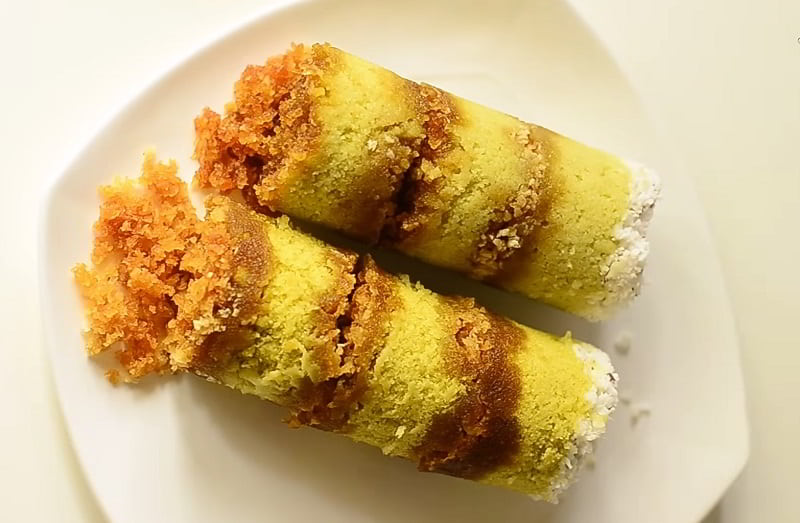
Kue putu is a popular Indonesian snack that is loved by both locals and tourists. This delicious dish is made from a combination of pandan leaves, rice flour, palm sugar, and grated coconut, resulting in a unique and delectable treat. To make kue putu, the rice flour (colored green with pandan leaves) is mixed with water to create a smooth batter, which is then poured into bamboo tubes. These tubes are then steamed, resulting in a cylindrical shape with a hollow center. Once cooked, the kue putu is carefully removed from the tubes and filled with sweet palm sugar. It is then topped with grated coconut, giving it a delightful texture and flavor. The combination of the soft and slightly chewy rice flour outer layer, the sweet and gooey palm sugar filling, and the fragrant grated coconut creates a harmonious blend of flavors and textures. Kue putu is typically enjoyed as a snack or dessert, and it is often served with a cup of hot tea or coffee. Whether you are exploring the bustling streets of Jakarta or relaxing on a beach in Bali, kue putu is a must-try Indonesian snack that will surely satisfy your sweet cravings.
Tapioca Chips
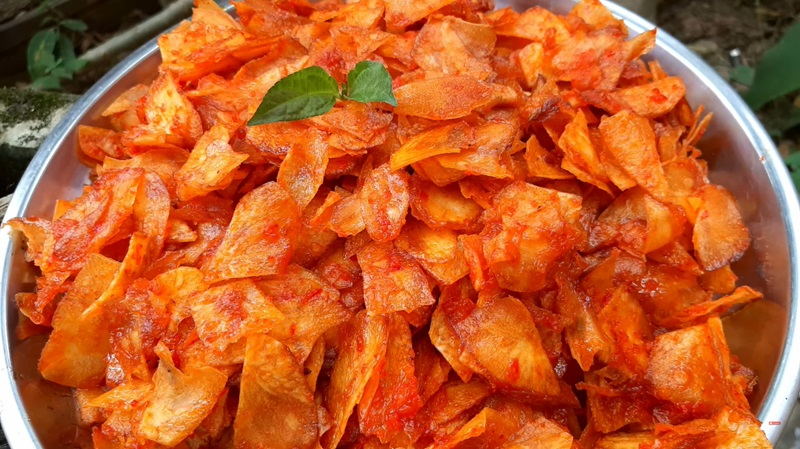
Tapioca chips, also known as keripik singkong in Indonesian, are a popular and delicious snack food in Indonesia. Made from the starchy root of the cassava plant, tapioca chips are thinly sliced and deep-fried to achieve a crispy texture. They are commonly seasoned with various spices and flavors, adding a burst of taste to every bite. Tapioca chips come in a variety of flavors, ranging from the classic salted version to more adventurous options like barbeque, cheese, or spicy chili. This diversity allows snack enthusiasts to find their preferred tastes and enjoy them on different occasions. The process of making tapioca chips involves peeling and washing the cassava roots before slicing them into thin chips. The slices are then fried in hot oil until they turn golden brown and become crispy. The result is a savory and addictive snack that can be enjoyed on its own or paired with other dishes. Tapioca chips are not only a popular snack among Indonesians but also enjoyed by people from various cultures around the world. Their light and crispy texture, combined with the wide range of flavors, make tapioca chips a delightful treat for any snacking occasion.
Ang Ku Kueh
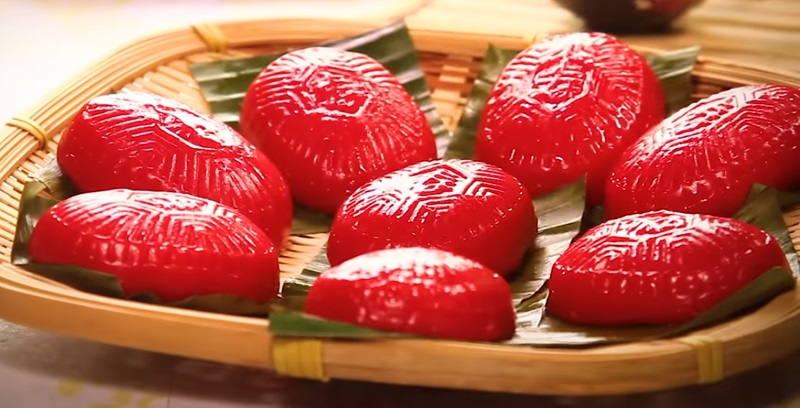
Ang ku kueh stands as a cherished delicacy in Indonesia, capturing the hearts of both locals and tourists. This charming treat takes the form of a petite, oval-shaped cake crafted from glutinous rice flour, encasing a delectable sweet filling. Also known as "red tortoise cake" in English, the name is a nod to its unique resemblance to a tortoise shell. The exterior of ang ku kueh boasts a soft and chewy consistency, achieved through the steaming process. The filling, often a blend of mung bean paste or ground peanuts with sugar, contributes a harmonious sweet, and savory dimension to the overall flavor profile. Ang ku kueh finds its place as a popular tea-time snack or a post-meal dessert. Easily accessible in local markets and street food stalls throughout Indonesia, this delightful treat is freshly prepared and served warm. The juxtaposition of the tender outer layer and the flavorful filling creates a satisfying interplay of textures and tastes, making ang ku kueh a treasured indulgence for individuals of all ages.
Lemper
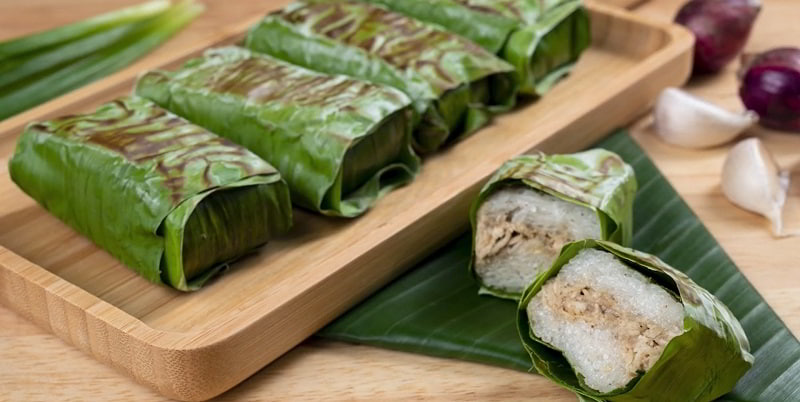
Lemper is a popular Indonesian snack that is both delicious and satisfying. This traditional dish is made from sticky rice that is seasoned with coconut milk and filled with various savory fillings. The rice is first cooked and then pounded into a smooth, sticky texture before being wrapped around the filling. The filling of Lemper can vary, but it is typically made from shredded chicken or beef that has been cooked with aromatic spices such as garlic, shallots, and coriander. Other variations include shrimp, fish, or even vegetarian options. The filling is mixed with a generous amount of coconut milk and then rolled into a log shape before being wrapped in the sticky rice. Lemper is usually served in bite-sized portions, making it perfect for snacking. It has a soft and chewy texture, with the sticky rice providing a comforting base for the flavorful filling. It is often wrapped inside a banana leaf or tinfoil. The combination of the fragrant spices and the creamy coconut milk creates a rich and satisfying taste that is loved by many. Whether enjoyed as a quick snack or as part of a larger meal, Lemper is a delicious and versatile Indonesian dish that is sure to please any palate.
Fish Cracker
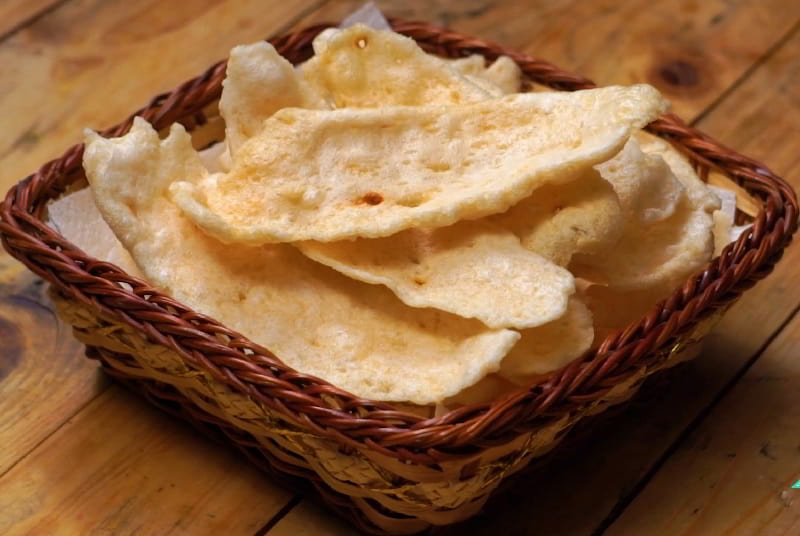
Fish crackers, or kerupuk ikan, stand out as a beloved Indonesian snack appreciated for its crispy and flavorful qualities. Crafted from a blend of fish meat, tapioca flour, and an assortment of spices, this treat has garnered widespread affection across all age groups. The process of creating fish crackers involves finely mincing the fish meat and combining it with tapioca flour, salt, and pepper. The resulting mixture is molded into different shapes (flat, cylindrical) before undergoing a deep-frying process that imparts a light and crispy texture. The outcome is a delightful snack boasting a unique fishy essence and a satisfying crunch. Enjoyed independently or as a complement to Indonesian meals, fish crackers often accompany spicy sambal or peanut sauce for an added burst of flavor. Beyond their delicious appeal, these crackers serve as a noteworthy protein source. Whether sought as a quick snack or a flavorful addition to a meal, fish crackers prove to be an essential taste of Indonesian cuisine. Their irresistible crunch and distinctive taste are sure to leave you yearning for more.
Pie Tee
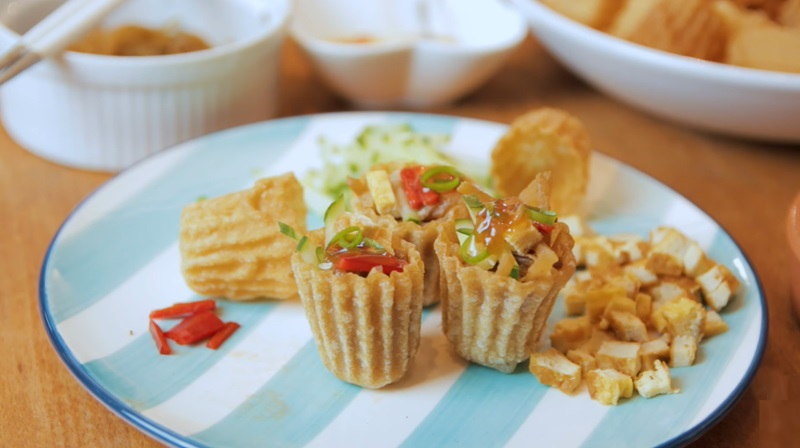
Pie tee is a popular snack in Indonesia that is loved by locals and visitors alike. It is a delicate and crispy appetizer that consists of a small, crispy pastry cup filled with a delicious mixture of vegetables and toppings. The pastry cup is made from a mixture of flour, salt, and water, which is shaped into a cone-like shape and deep-fried until golden and crispy. The filling of the pie tee is where the flavors really come alive. It typically consists of a combination of finely chopped vegetables such as carrots, bamboo shoots, and bean sprouts, mixed with a tangy and savory sauce made from soy sauce, vinegar, and spices. Some variations may also include shrimp, chicken, or tofu for added protein. Pie tee is commonly served as a snack or appetizer during special occasions and festive celebrations, but it can also be found at street food stalls and restaurants throughout Indonesia. The combination of the crispy pastry shell and the flavorful vegetable filling creates a delightful and satisfying bite-sized treat that is sure to leave you wanting more.
Rempeyek
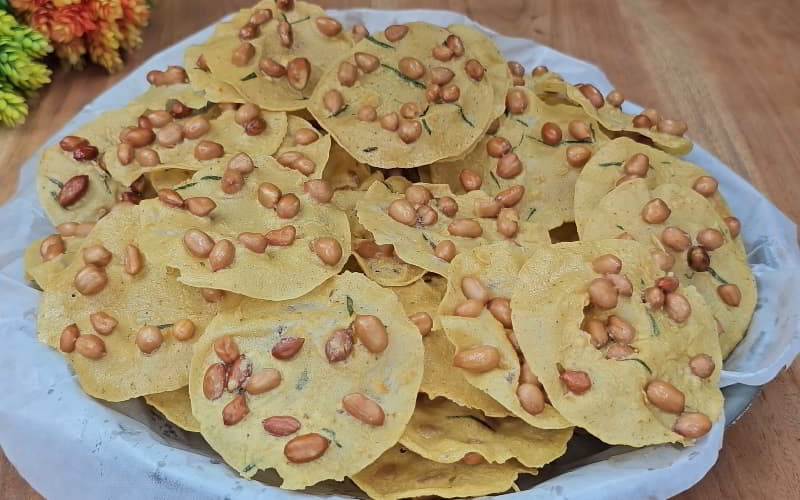
Rempeyek, a cherished Indonesian snack, has earned acclaim for its delectable flavor and satisfying crunch. This traditional delicacy is crafted from a blend of rice flour, coconut milk, and an array of spices, creating a batter that is deep-fried to perfection. What distinguishes rempeyek is its distinctive shape and texture, setting it apart from other snacks. A key component that contributes to its uniqueness is the inclusion of peanuts, embedded in the batter prior to frying, delivering a delightful nutty essence and an extra layer of crispiness to each bite. Common spices like garlic, turmeric, coriander, and chili further enrich rempeyek's aromatic and savory profile. While it is often relished as a standalone snack, rempeyek complements other Indonesian dishes such as nasi uduk (coconut rice) or serves as a flavorful side dish alongside main meals. Its versatility makes it suitable for enjoyment at any time of the day. Whether sought as a quick bite or a flavorful accompaniment, rempeyek stands out as a must-try Indonesian snack, promising to satiate cravings for something crispy and delicious.
Dadar Gulung
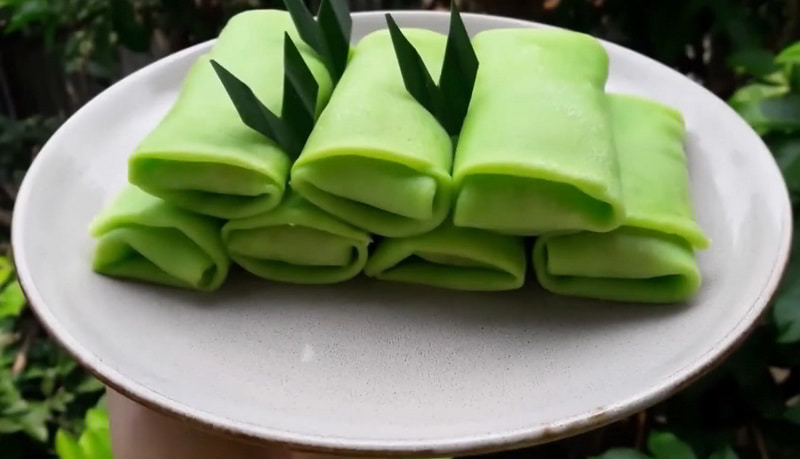
Dadar gulung, a beloved Indonesian snack, holds a special place in the hearts of both locals and visitors. This delightful treat features thin crepes generously filled with a sweet and aromatic coconut concoction. Translating to "rolled pancake" in English, the name aptly describes the preparation method involved in crafting this delicacy. The batter for dadar gulung is created from a blend of rice flour, coconut milk, and pandan juice, imparting the crepes with a vibrant green hue. The batter is skillfully poured onto a hot griddle, and spread thinly to form delicate pancakes. Once cooked, the crepe is delicately rolled, and a lavish amount of grated coconut mixed with palm sugar is introduced to the center. The sweet and fragrant filling harmoniously complements the slightly savory crepes. Dadar gulung is a sought-after snack or dessert, readily available in traditional markets and street food stalls throughout Indonesia. The amalgamation of the soft, velvety crepes with the sweet, gooey coconut filling promises a delightful burst of flavors and textures in each mouthful. It's an indulgence not to be overlooked while immersing oneself in the diverse culinary traditions of Indonesia.
Bahulu
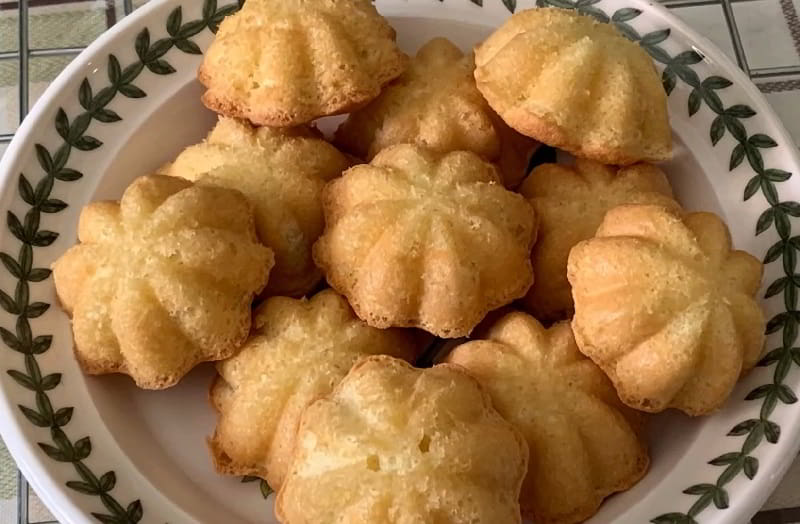
Bahulu is a snack popular in Indonesia that is loved by locals and tourists alike. These bite-sized treats are made from a simple batter consisting of flour, eggs, sugar, and vanilla essence. The batter is then poured into special molds, which are usually made of cast iron or aluminum, and baked until golden brown. Bahulu has a unique texture that is soft and fluffy on the inside, while slightly crispy on the outside. The flavor is subtly sweet, making it a perfect accompaniment to a cup of tea or coffee. It is often served during special occasions and festivals and is a staple at Indonesian weddings. What makes Bahulu even more special is the wide variety of molds available, each with its own unique shape and design. From traditional floral patterns to modern geometric shapes, these molds add a decorative touch to the snack. The versatility of Bahulu is another reason for its popularity. It can be enjoyed plain, or you can get creative and add your own twist by incorporating ingredients like chocolate chips, raisins, or grated coconut. Overall, Bahulu is a delightful snack that offers a delightful combination of flavors and textures. Whether enjoyed on its own or as part of a larger meal, it is a must-try for anyone looking to explore the rich culinary heritage of Indonesia.
Brem
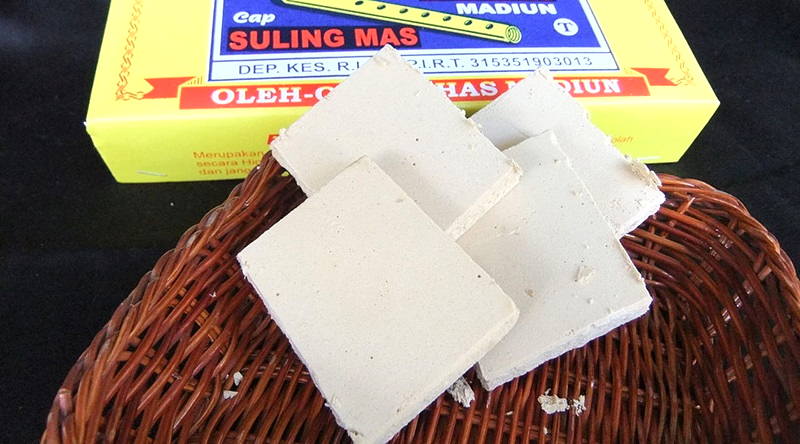
Brem is a traditional Indonesian fermented food and beverage made from glutinous rice or black glutinous rice. It is commonly associated with Central Java and East Java provinces of Indonesia. Brem is typically enjoyed as a snack or dessert, and it's also sometimes used in cooking. To make brem, glutinous rice or black glutinous rice is cooked and then mixed with yeast or a starter culture called ragi. This mixture is left to ferment for a period of time, allowing the natural fermentation process to occur. During fermentation, the rice starches are converted into sugars and alcohol, resulting in a mildly sweet and slightly alcoholic product. Brem can vary in flavor and texture depending on factors such as the type of rice used, the fermentation process, and any additional ingredients or flavorings added. It may have a slightly tangy taste due to the fermentation process, and it can range from soft and pudding-like to firm and chewy. Brem is often enjoyed on its own as a snack, but it can also be used as an ingredient in various desserts and dishes. It's a popular traditional food in Indonesia, particularly during special occasions and cultural celebrations.
Pineapple Tart
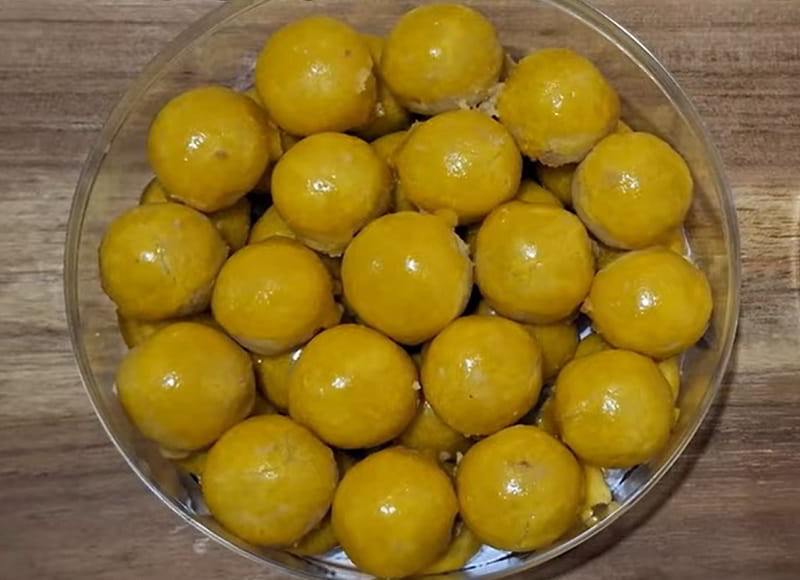
Pineapple tart is a delightful dessert snack that is loved by locals and visitors alike. This tasty treat consists of a buttery and crumbly pastry shell filled with a sweet and tangy pineapple jam filling. The pastry is made with a combination of flour, butter, sugar, and egg yolks, resulting in a melt-in-your-mouth texture. The pineapple jam filling is made by cooking fresh pineapple chunks with sugar and spices until it thickens and develops a rich golden color. The jam is then spooned into the pastry shells and baked until the pastry turns a beautiful golden brown. The combination of the buttery pastry and the sweet and zesty pineapple filling creates a perfect balance of flavors. These bite-sized treats are often enjoyed during festive occasions such as Chinese New Year or as an everyday indulgence with a cup of tea or coffee. Pineapple tarts are not only delicious but also visually appealing, often shaped into small bite-sized rounds or decorative shapes. They are a true crowd-pleaser and a must-try when exploring the diverse and vibrant world of Indonesian snack foods.
Kaasstengels
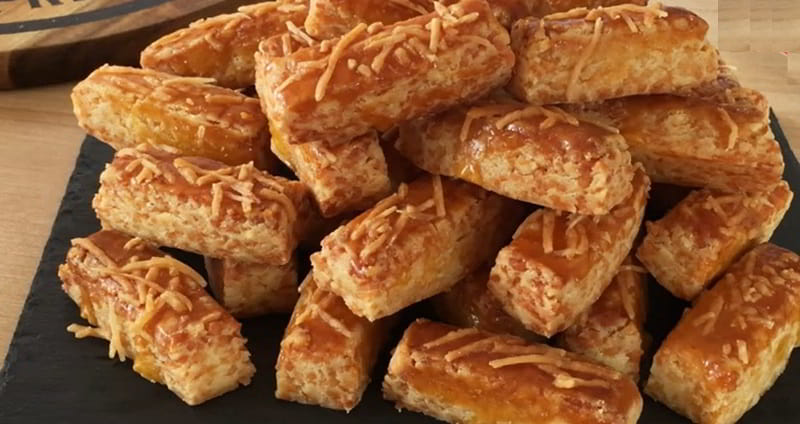
Kaasstengels is a delectable Indonesian snack that has gained popularity for its unique blend of flavors and textures. Originating from the Dutch influence in Indonesia, this dish has become a favorite among locals and tourists alike. Kaasstengels are essentially cheese sticks, made with a combination of flour, butter, and grated cheese. The dough is rolled into small sticks and then deep-fried until golden brown and crispy. The cheese filling inside oozes out when you take a bite, creating a delightful explosion of flavors. What sets Kaasstengels apart from other snacks is its distinct taste. The combination of the savory cheese and the slight sweetness of the dough creates a perfect balance that is both satisfying and addictive. It is commonly enjoyed as a snack with a cup of tea or coffee, making it a versatile treat for any time of the day. Whether you're in a bustling city or a small village, you can easily find Kaasstengels in local bakeries or street food stalls. Its popularity has even spread beyond Indonesia's borders, with many Indonesian restaurants around the world including it on their menu. Overall, Kaasstengels is a must-try snack for anyone visiting or exploring Indonesian cuisine. Its simplicity, unique flavor profile, and crunchy texture make it a delightful treat that will leave you craving for more.
Lemang
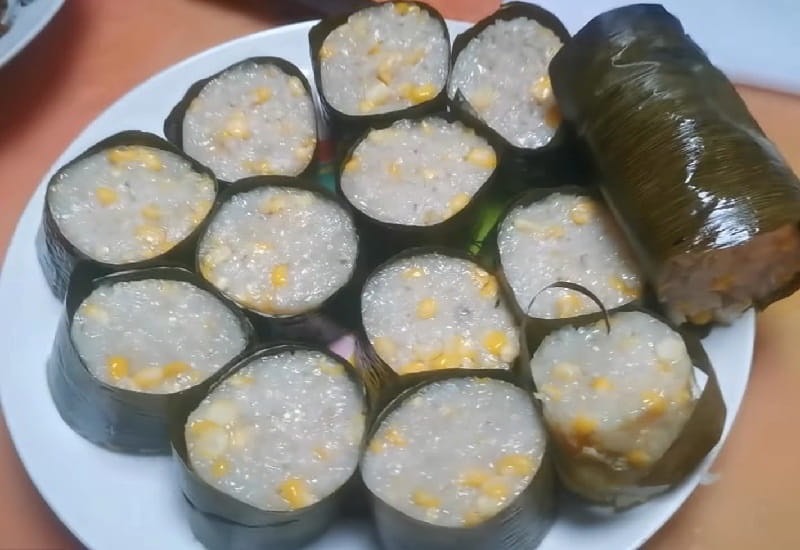
Lemang is a traditional Indonesian snack food that is made from glutinous rice and cooked inside a hollowed bamboo tube. This delicious dish is commonly found in the regions of Indonesia with a large Malay population, such as Sumatra and Kalimantan. The process of making lemang begins with soaking the glutinous rice for several hours before it is mixed with coconut milk and salt. The mixture is then stuffed into the bamboo tube, which is lined with banana leaves to prevent the rice from sticking to the bamboo. The tube is placed over a fire and cooked for several hours until the rice becomes soft and sticky. The result is a fragrant and flavorful snack that is often enjoyed with other dishes such as rendang or sambal. Lemang has a unique smoky taste from being cooked in bamboo, and the texture is delightfully chewy. It is often served during festive occasions such as Eid al-Fitr or weddings, but can also be found at local markets or food stalls throughout the year. Overall, lemang is a beloved Indonesian snack food that showcases the country's rich culinary heritage and is sure to satisfy any craving for a tasty and filling treat.
Bika Ambon
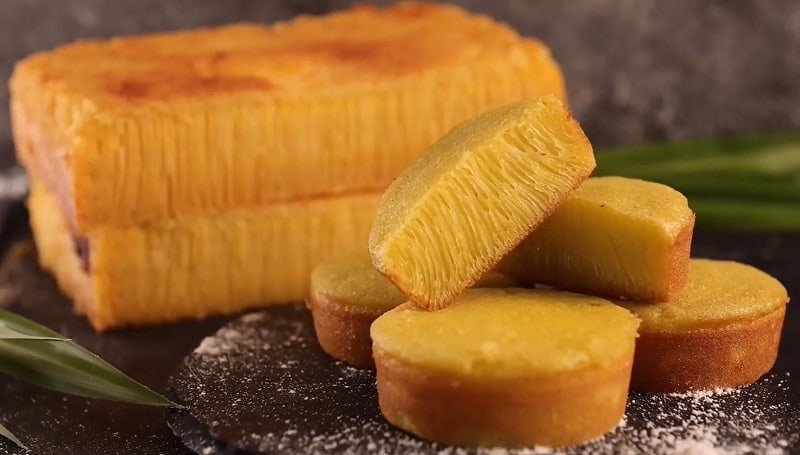
Bika ambon is a beloved dessert in the culinary scape of Indonesia. It is a sweet and spongy cake that is made from a unique combination of ingredients, giving it a distinct taste and texture. The main ingredients used in making bika ambon are tapioca flour, coconut milk, eggs, sugar, and yeast. The preparation process of bika ambon involves fermenting the batter for several hours, which gives the cake its signature porous and airy texture. The addition of coconut milk adds a subtle hint of sweetness and fragrance to the cake, making it an irresistible treat for those with a sweet tooth. Bika ambon is often enjoyed as a snack or dessert, and it is commonly found in local markets and street food stalls across Indonesia. It is typically served in small, bite-sized pieces and can be eaten on its own or paired with a cup of hot tea or coffee. With its soft and fluffy texture and delightful sweetness, bika ambon is a popular choice among locals and tourists alike. Its unique flavor and texture make it a must-try snack for anyone visiting Indonesia or seeking to explore the country's diverse culinary offerings.
Serabi
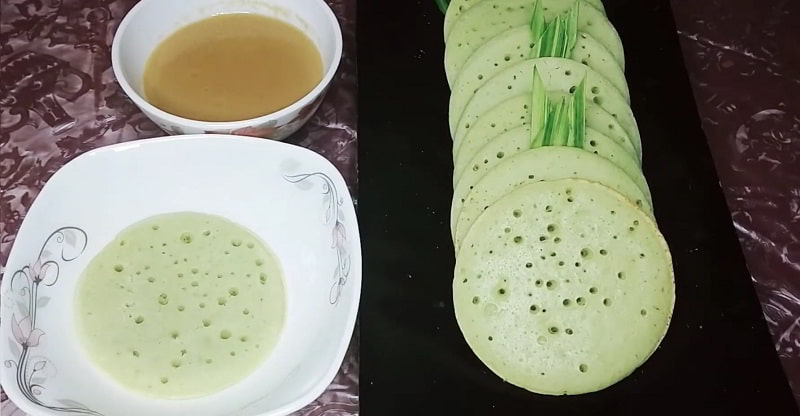
Serabi, a classic Indonesian delicacy reminiscent of pancakes, is crafted from a batter of rice flour blended with coconut milk or cream, incorporating shredded coconut for texture. Traditionally, serabi leans towards sweetness, often paired with kinca—a luscious coconut sugar syrup hailing from the Sundanese culinary tradition. In its simplest form, this treat comprises a mixture of rice flour, coconut milk, and coconut sugar, cooked atop a small earthenware pan over charcoal. Occasionally, pandan leaf juice is infused into the batter to infuse fragrance and a hint of green hue. Throughout the cooking process, additional toppings may be introduced to enhance the flavor profile. Serabi's charm lies in its soft, slightly chewy texture and its delightful coconut-infused taste, making it a beloved indulgence in Indonesian cuisine enjoyed across generations.
Jajan Pasar
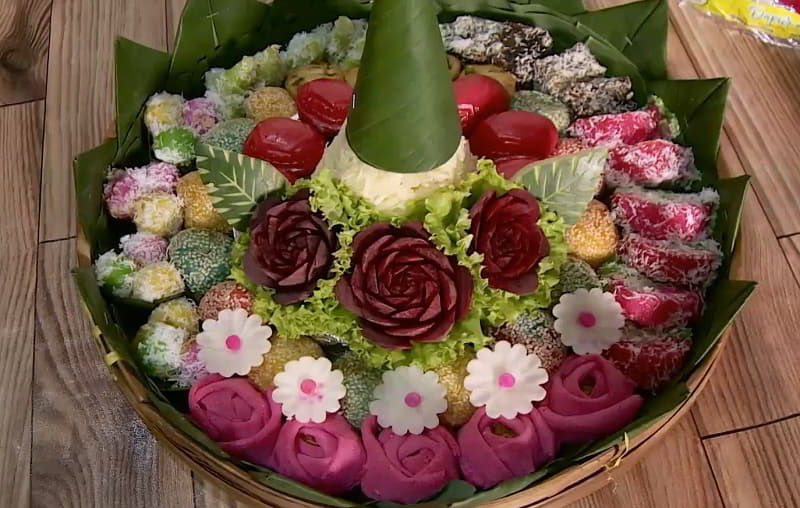
Jajan pasar, a popular Indonesian snack food, is a vibrant and diverse culinary delight. Translated as "market snacks," jajan pasar dishes are typically sold in traditional markets or street stalls, providing locals and visitors with an array of flavors and textures. These snacks come in various forms, including savory and sweet options. Savory jajan pasar dishes often feature ingredients like rice flour, coconut milk, and spices. Examples include klepon, sweet rice ball filled with molten palm sugar, and lemper, glutinous rice filled with chicken or fish. Other popular sweet snacks include serabi, a pancake crafted from rice flour, coconut milk, and coconut cream, and putu mayang, a string hooper dish made with coconut milk and rice flour. Jajan pasar dishes are not only delicious but also visually appealing, with their vibrant colors and intricate designs. Whether you're exploring a bustling market or strolling along a street, indulging in jajan pasar is a delightful way to experience the rich and diverse flavors of Indonesian cuisine.
Krupuk Kulit
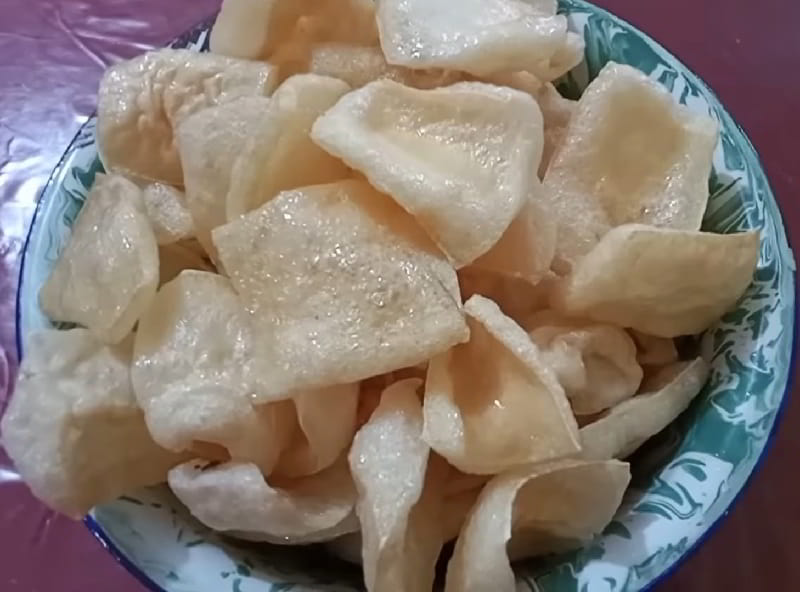
Krupuk kulit, a timeless Indonesian cracker, is intricately crafted from cattle skin, typically sourced from cows or water buffaloes. The traditional method involves meticulously preparing the soft inner skin, dicing it into manageable pieces, and subjecting it to sun-drying until it achieves a hardened state, shedding a significant portion of its water content in the process. Following this, the dried skin undergoes a transformative stage through deep-frying in abundant hot cooking oil. The heat causes the skin to expand, forming bubbles and culminating in a texture that is both crispy and satisfying. To preserve and extend the longevity of its crispiness, the resulting fried cattle skin is thoughtfully packaged in vacuum-sealed plastic bags. This meticulous step ensures that the krupuk kulit retains its delightful crunchiness until it reaches the consumer. Rooted in tradition, this process not only captures the essence of Indonesian culinary heritage but also highlights the careful craftsmanship involved in creating this beloved and flavorsome snack.
Roti Jala
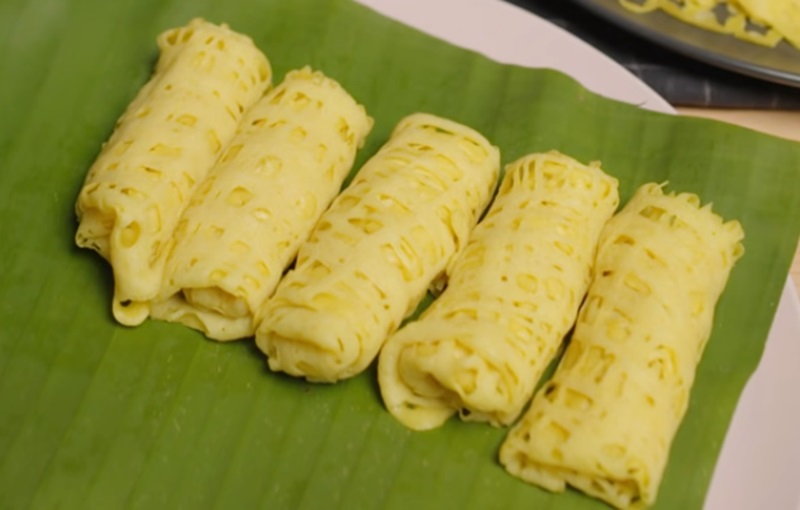
Roti jala, also recognized as "net bread," stands out as a delectable and popular Indonesian snack, though its roots trace back to Malaysia. The dish has seamlessly integrated into Indonesian cuisine, gaining widespread admiration. Crafted from a straightforward batter comprising flour, eggs, coconut milk, and a touch of turmeric powder for its vibrant yellow hue, roti jala is a visually striking treat. The batter is skillfully poured through a specialized funnel-like container with multiple small holes onto a hot skillet or griddle, forming a crisscross pattern reminiscent of a net or lace-like design. The delicate strands of batter cook swiftly, developing a subtle crispiness. Roti jala is often paired with savory accompaniments such as curry, rendang, or sambal. The bread's net-like structure excels in absorbing the rich and spicy flavors of these dishes, resulting in a harmonious fusion of taste and texture. Beyond its visual appeal, roti jala offers a deeply satisfying eating experience. The amalgamation of soft and fluffy bread with flavorful curries or sambal delivers a delightful explosion of flavors in each bite. For those eager to embark on a culinary exploration of diverse and delicious Indonesian snack foods, roti jala is undoubtedly a must-try dish.
Amplang
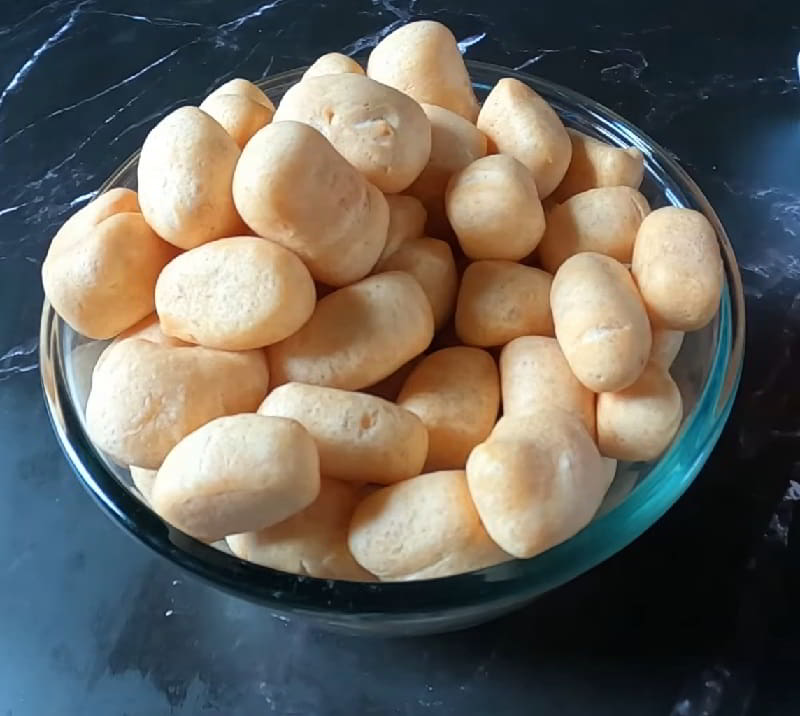
Amplang is a popular Indonesian snack that originates from the city of Tarakan in North Kalimantan. This unique and flavorful snack is made from a combination of fish, tapioca starch, and various spices. The dough is shaped into small cubes or elongated shapes and then deep-fried until crispy. Amplang is known for its distinct taste and crunchy texture. The fish used in making amplang can vary, but commonly it is made from mackerel or tenggiri (wahoo fish). The fish is finely ground and mixed with tapioca starch, giving it a smooth and chewy consistency. The key to amplang's deliciousness lies in the blend of spices used in the recipe. Garlic, onion, salt, and pepper are commonly added to enhance the flavor. Some variations also include additional ingredients like chili powder or shrimp paste, giving it a hint of spiciness. This savory snack is often enjoyed as a side dish or as a snack with a cup of tea or coffee. It is not only popular in Tarakan but also available in various parts of Indonesia. Amplang is a beloved snack that offers a delightful combination of flavors and textures, making it a must-try for snack enthusiasts.
Kripik
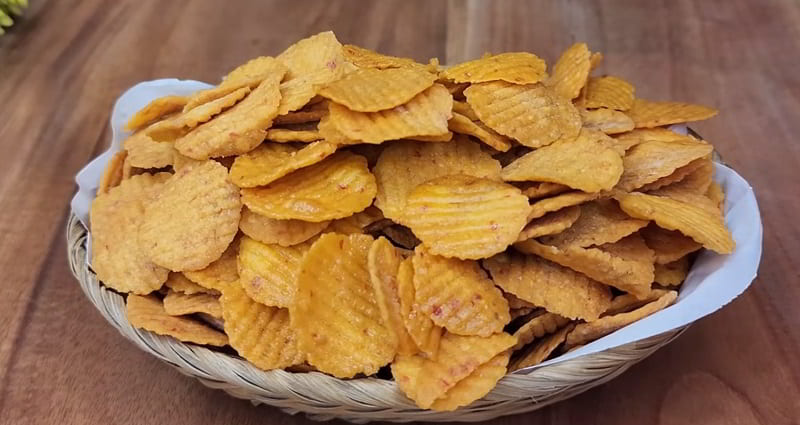
Kripik, a beloved Indonesian snack, has garnered favor among both locals and tourists. Translating to "crisps" in English, kripik encompasses a diverse array of deep-fried or baked snacks, featuring ingredients ranging from fruits and vegetables to seafood. Among the renowned variations is kripik pisang, crafted from thinly sliced bananas deep-fried to a crispy, golden brown perfection. A delightful blend of sugar and salt is often sprinkled on kripik pisang, creating an ideal harmony of sweet and savory flavors. Another popular kripik variant is kripik tempe, fashioned from fermented soybean cake. Thinly sliced tempe undergoes deep-frying until achieving a crispy texture, accentuated by a flavorful blend of spices. Additional kripik varieties include kripik singkong (cassava), kripik kentang (potatoes), and kripik ikan (fish). These snacks are readily available in traditional markets, street food stalls, and supermarkets across Indonesia. Beyond their delicious appeal, kripik dishes offer a convenient snack option, enjoyed either on their own or as a flavorful side dish accompanying a meal. When in Indonesia, seize the opportunity to savor these crispy and flavorful kripik snacks.
Nagasari
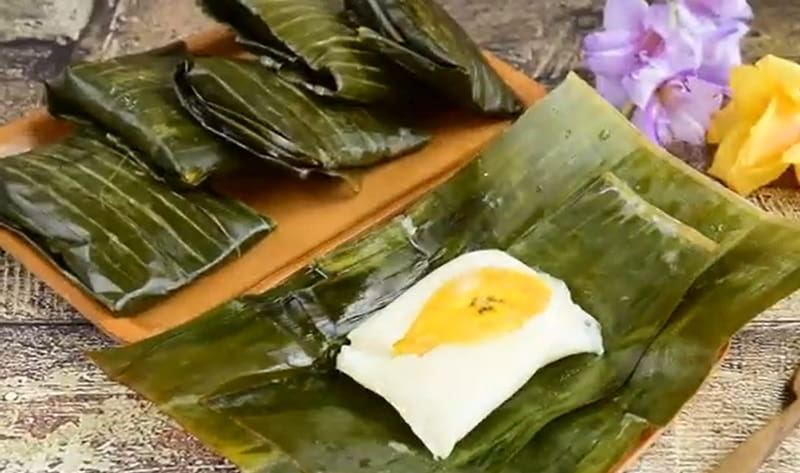
Nagasari, a cherished delicacy rooted in Javanese culinary heritage, is a traditional Indonesian steamed cake. Crafted from a blend of rice flour, coconut milk, and sugar, its core features include a luscious filling of ripe banana encased within a tender casing. To preserve its authenticity, nagasari is enveloped in fragrant banana leaves before undergoing the steaming process. This culinary delight embodies the essence of Indonesian flavors, with the rice flour providing a soft texture, the coconut milk infusing richness, and the sweetness of sugar complementing the natural sweetness of the banana. As it steams, the flavors intermingle, creating a harmonious blend that tantalizes the taste buds. Nagasari stands as a symbol of tradition and community, enjoyed during special occasions and everyday gatherings, offering a taste of Indonesia's rich cultural and culinary heritage.
Kue Pancong
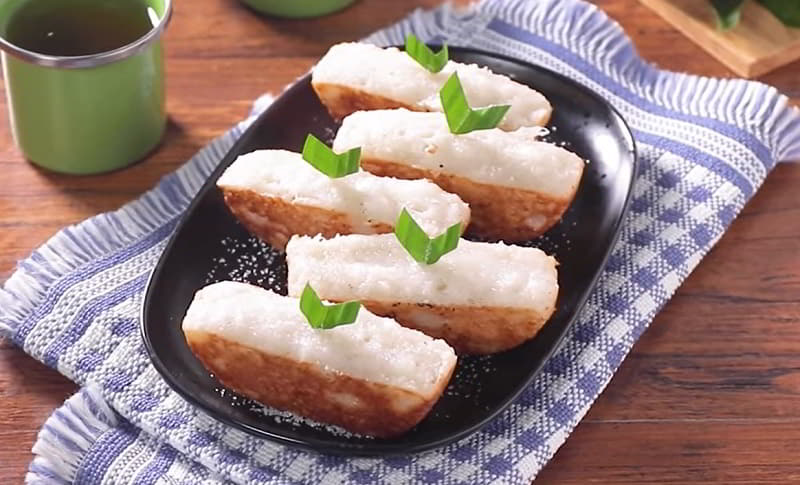
Kue Pancong is a traditional Indonesian coconut cake that holds a special place in Indonesian culinary culture. Originating from the Betawi people of Jakarta, this delightful cake is cherished for its unique flavor and texture. To prepare Kue Pancong, a batter is created from a mixture of rice flour, coconut milk, sugar, and a pinch of salt. This batter is then poured into a special mold pan with small, rectangular basins. The cakes are then grilled or baked until golden brown and crispy on the outside while remaining soft and moist on the inside. The coconut flavor is prominent in Kue Pancong, thanks to the generous use of coconut milk in the batter. The cakes often have a slightly crispy and caramelized exterior, which contrasts beautifully with the soft and fluffy interior. Kue Pancong is typically enjoyed as a snack or dessert, either on its own or accompanied by a cup of tea or coffee. Its unique shape and delicious flavor make it a beloved treat among Indonesians, particularly in Jakarta and other parts of Java where it originated.
Rengginang
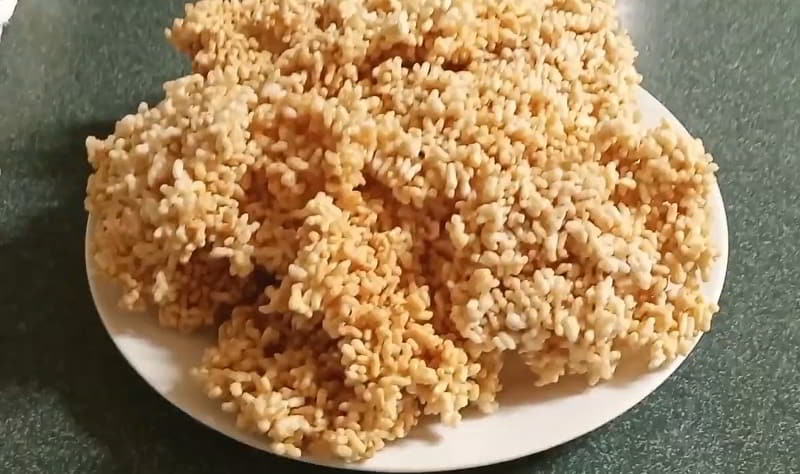
Rengginang, also known as ranginang, represents a delectable variety of Indonesian rice crackers renowned for their unique texture and flavor. These savory treats are meticulously crafted from cooked glutinous sticky rice, expertly seasoned with a blend of aromatic spices. The mixture is then skillfully shaped into flat, rounded forms before being left to bask under the sun's rays for drying. Once sun-dried to perfection, the rengginang undergoes the final transformation through deep-frying in generous amounts of cooking oil, resulting in a delightful crispiness that tantalizes the palate. The marriage of spices with the rich flavor of glutinous rice ensures a satisfying culinary experience with every crunchy bite. Rengginang holds a special place in Indonesian cuisine, offering a beloved snack that is enjoyed across the archipelago for its irresistible taste and distinctive texture.
Milk Pie
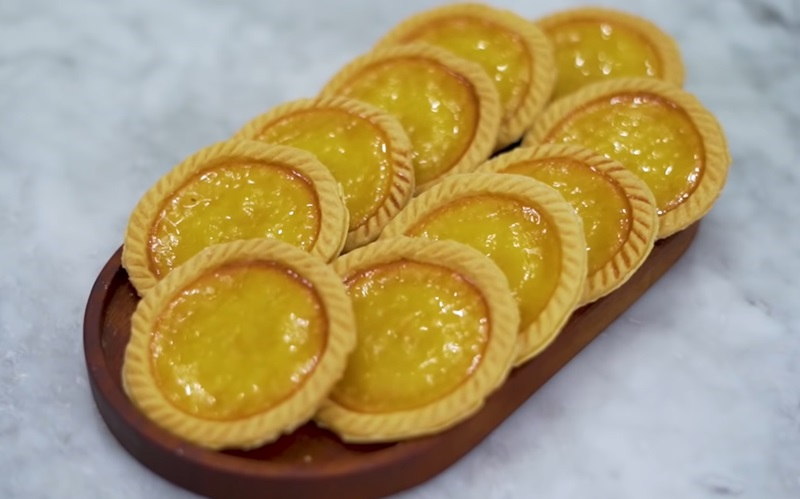
Milk pie, referred to as Pie susu in Indonesia, stands out as a delightful Indonesian delicacy, distinguished by its custard-filled shortcrust pastry. This traditional dessert presents a captivating blend of flavors, with a luscious filling composed of egg custard and condensed milk enclosed within a tender pastry shell. Notably, Pie susu boasts a distinctively flat profile, characterized by a thin layer of custard that harmonizes with the buttery richness of the pastry. While its appearance bears resemblance to the Portuguese pastel de nata, Pie susu maintains its own unique identity through the incorporation of Indonesian culinary influences and flavor profiles. This beloved pastry holds a special place in Indonesian gastronomy, captivating both locals and visitors alike with its exquisite taste and charming presentation, making it a cherished indulgence enjoyed across the archipelago.
Lupis
-1708385300.jpg)
Lupis, a beloved Indonesian delicacy, is a traditional sweet cake crafted from glutinous rice, banana leaves, coconut, and a delectable brown sugar sauce. To begin the process, glutinous rice undergoes soaking in a mixture of water, salt, and lime juice. Once adequately soaked, the rice is drained and portioned onto banana leaves, forming single-serving-sized portions that are meticulously wrapped. These rice parcels are then set aside while the syrup condiment is prepared. Coconut sugar is dissolved in water and brought to a gentle boil until it thickens to perfection. After unwrapping the lupis, grated coconut is generously sprinkled atop, followed by a drizzling of the luscious coconut sugar syrup. This delectable treat is then ready to be served, showcasing the harmonious blend of textures and flavors that epitomize Indonesian culinary heritage. Lupis holds a cherished place among Indonesian desserts, captivating palates with its irresistible sweetness and delightful presentation.
Kue Pukis
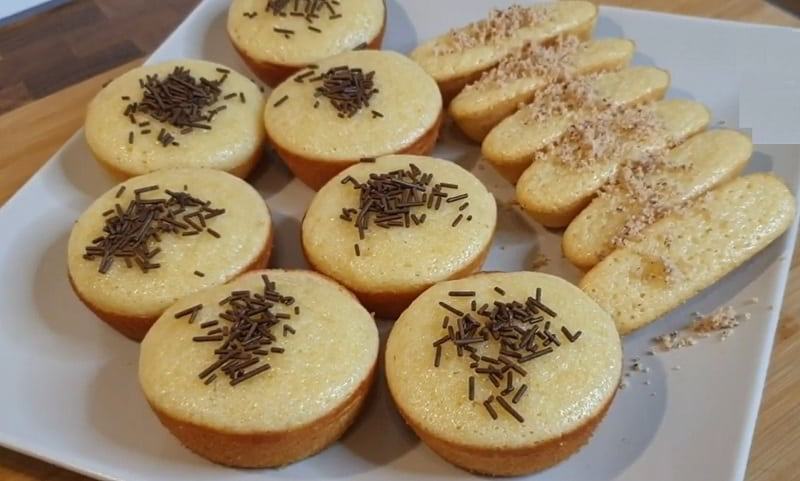
Kue Pukis is a traditional Indonesian snack or dessert renowned for its fluffy texture and delightful taste. These small cakes are similar to pancakes but with a unique shape and flavor. They are typically cooked in special molds with multiple indentations, resulting in a distinctive half-moon shape. To prepare Kue Pukis, a batter is made from a mixture of flour, coconut milk, eggs, sugar, and a hint of baking powder for leavening. This batter is poured into the molds and cooked until golden brown and fluffy. Kue Pukis can be enjoyed in various ways. Some people prefer them plain, while others like to add toppings such as grated cheese, chocolate sprinkles, or sweetened condensed milk. The result is a delightful snack or dessert with a soft, slightly chewy texture and a hint of coconut flavor from the coconut milk. Kue Pukis is a beloved treat in Indonesia, often found at local markets, street food stalls, and home kitchens. Its simple yet satisfying taste makes it a popular choice for any occasion.
Wajik
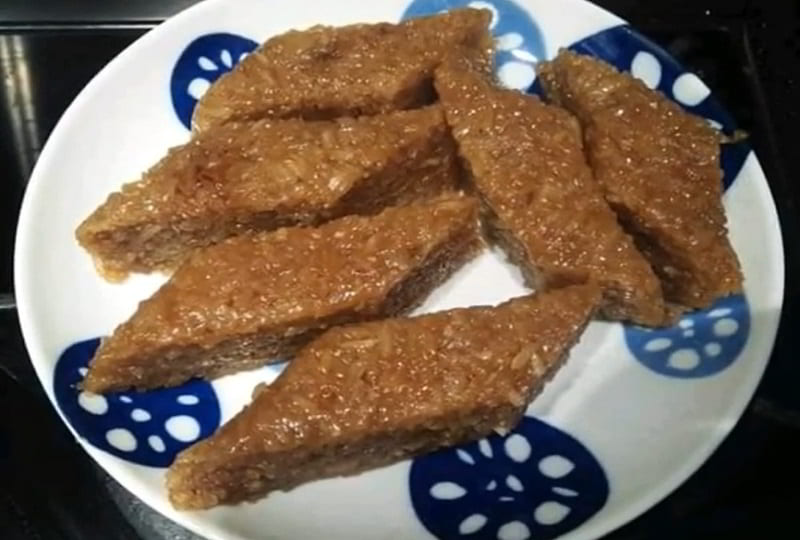
Wajik is a traditional Indonesian snack made from sticky rice, palm sugar, and coconut milk. It is a popular dish enjoyed during festive occasions and celebrations. To make wajik, glutinous rice is cooked with coconut milk until it becomes soft and sticky. Palm sugar, known as "gula aren", is then added to the mixture, giving the snack its sweet and caramel-like flavor. The mixture is further cooked until it thickens and can be easily molded. Once the wajik mixture has cooled down, it is pressed into a square or diamond-shaped mold. It is then left to set and firm up before being cut into individual pieces. The final result is a chewy and satisfying snack with a delightful combination of sweet and creamy flavors. Wajik is often served on a banana leaf, adding a hint of freshness and aroma to the dish. It is a beloved treat among Indonesians and is often enjoyed with a cup of tea or coffee. Its unique texture and rich taste make wajik a delightful snack that is cherished by many.
Arem-Arem
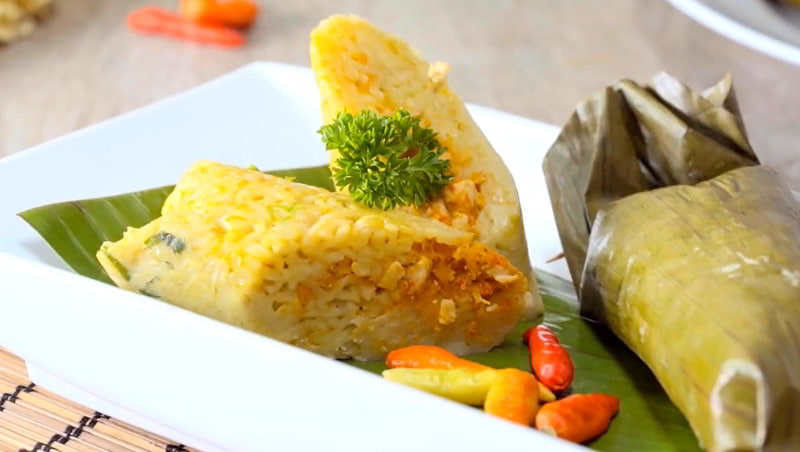
Arem-arem is a popular snack food in Indonesian cuisine that is loved by both locals and tourists. It is a delicious dish that consists of bite-sized rice rolls filled with various flavorful ingredients. The base of arem-arem is made from steamed rice that is mixed with coconut milk, giving it a slightly sweet and creamy taste. The filling of arem-arem can vary, but commonly includes ingredients like vegetables, tofu, tempeh, and shrimp. These ingredients are typically seasoned with a combination of spices such as garlic, shallots, and chili peppers, which adds a delightful kick to the dish. The filling is then wrapped in a banana leaf, giving it a unique and aromatic touch. Arem-arem is often enjoyed as a snack or appetizer. Its compact size makes it perfect for on-the-go eating, and it is commonly found in street food stalls and local markets throughout Indonesia. The combination of textures and flavors in arem-arem creates a delightful experience for the taste buds, making it a must-try snack for anyone visiting Indonesia.
Kue Cucur
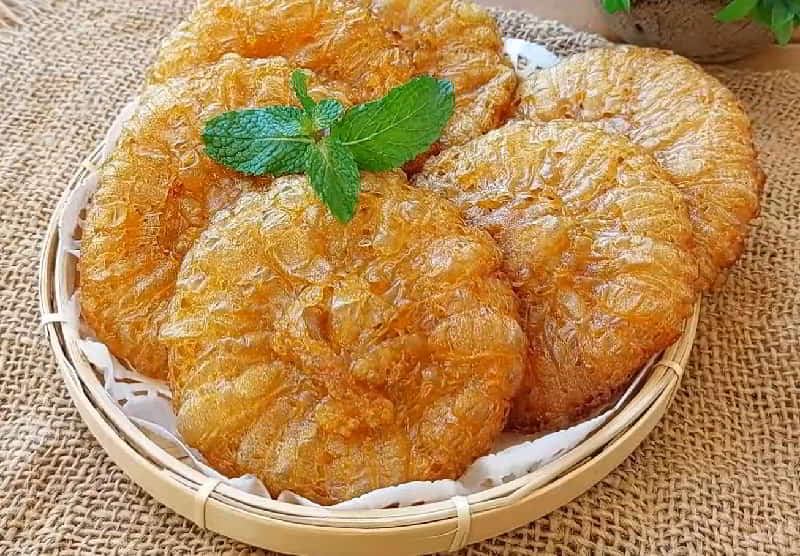
Kue cucur is a popular traditional Indonesian snack food that is loved by locals and visitors alike. It is a sweet and crispy treat that is made from a batter consisting of rice flour, coconut milk, and palm sugar. The batter is then deep-fried until golden brown, resulting in a crispy outer layer while maintaining a soft and chewy interior. Typically served in small bite-sized pieces, kue cucur is often enjoyed as a snack or dessert. It is commonly found in street food stalls and traditional markets throughout Indonesia. The snack is known for its distinctive shape, resembling small, round pancakes with irregular edges. Kue cucur can be enjoyed plain, with a sprinkle of powdered sugar, or with a variety of toppings. Some popular toppings include grated coconut, palm sugar syrup, or a combination of both, adding a rich and sweet flavor to the already delicious treat. With its delightful combination of textures and flavors, kue cucur is a delightful snack that provides a taste of Indonesian culinary heritage. Whether enjoyed on its own or paired with a cup of tea or coffee, this traditional dish is sure to satisfy any sweet tooth.
Jemput-Jemput
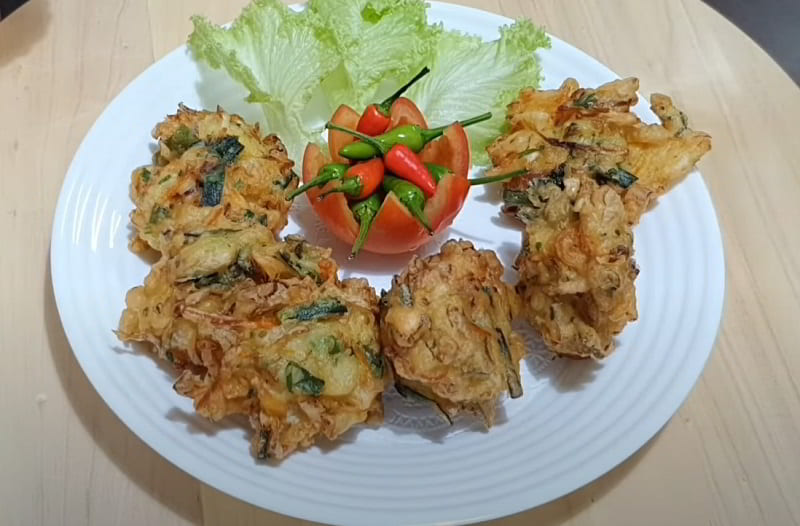
Jemput-jemput is a popular Indonesian snack that is both delicious and satisfying. These crispy fritters are made from a simple batter consisting of flour, water, salt, and various spices. The batter is then mixed with grated vegetables such as carrots, cabbage, and bean sprouts, giving the fritters a delightful crunch and a burst of flavors. Jemput-jemput is typically deep-fried until golden brown, resulting in a crispy exterior with a soft and fluffy interior. It is commonly enjoyed as a snack or appetizer, especially during afternoon tea or as a street food option. The versatility of jemput-jemput allows for various variations to cater to different tastes. Some variations include adding corn kernels, shrimp, or even cheese for an extra savory twist. These fritters can be served with a variety of dipping sauces, such as spicy sambal or a sweet and tangy peanut sauce, enhancing the overall taste experience. The beauty of jemput-jemput lies in its simplicity and the use of fresh ingredients. It is a beloved snack that brings people together, whether it's during family gatherings, casual get-togethers, or as a tasty treat on the go.
Bakpia Pathok
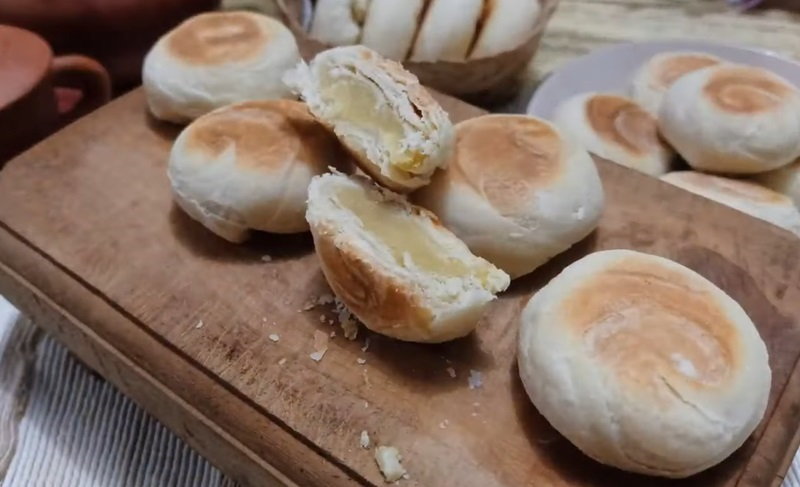
Bakpia Pathok is a popular Indonesian snack originating from the city of Yogyakarta. It is a sweet pastry filled with various fillings, typically mung bean or green bean paste. The name "Pathok" refers to the area in Yogyakarta where it is believed to have originated. The pastry is made from a combination of flour, sugar, and butter, resulting in a soft and slightly chewy texture. The filling is made by cooking the beans until they are soft and then sweetening them with sugar. The paste is then wrapped in the pastry dough and sealed. Bakpia Pathok is typically small in size, about the size of a golf ball, making it a perfect bite-sized snack. It is often enjoyed with a cup of tea or coffee. The flavor is sweet and slightly nutty, with a hint of butteriness from the pastry. Bakpia Pathok is not only a delicious snack but also a popular souvenir from Yogyakarta. It can be found in various flavors and variations, such as chocolate, cheese, or durian. Whether enjoyed as a snack or brought home as a gift, Bakpia Pathok is a delightful treat that showcases the rich culinary heritage of Indonesia.
Bolu Kukus

Bolu kukus is a popular snack food in Indonesia. Made from a simple batter of flour, sugar, eggs, and a touch of baking powder, this soft and fluffy cake is steamed rather than baked, resulting in a unique texture and delicate flavor. Bolu kukus comes in various flavors, such as pandan, chocolate, cheese, and even fruits like banana or strawberry. It is often served plain or with a light dusting of powdered sugar on top. The cake is traditionally steamed in small individual molds, giving it a charming bite-sized appearance. This snack is enjoyed by people of all ages and is commonly found in traditional markets, street food stalls, and even in modern bakeries across Indonesia. It is perfect for tea time or as a light dessert. The moist and airy texture of bolu kukus makes it an irresistible treat that melts in your mouth. Whether enjoyed on its own or paired with a cup of hot tea or coffee, bolu kukus is a delightful snack that embodies the essence of Indonesian culinary culture.
Kolak
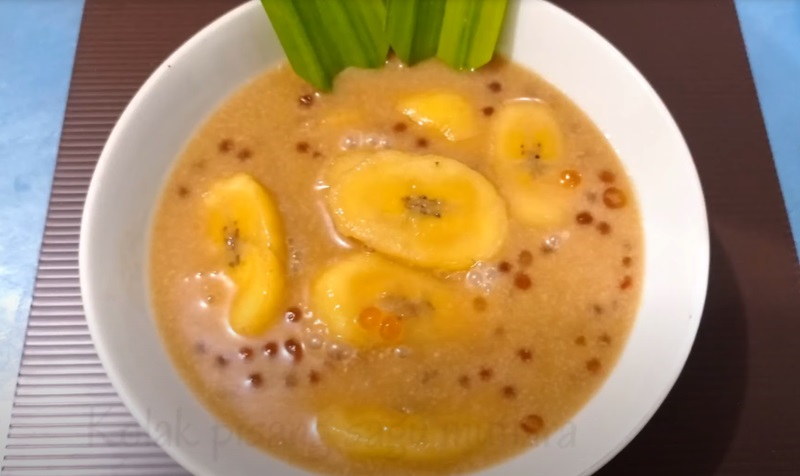
Kolak, alternatively spelled kolek, stands as a beloved Indonesian dessert renowned for its sweet and comforting flavors. This delightful treat is crafted from a base of palm sugar or coconut sugar, combined with creamy coconut milk and fragrant pandanus leaf. Variations of kolak abound, with the addition of ingredients such as banana giving rise to the popular variant known as kolak pisang or banana kolak. Other delightful additions include tapioca pearls, pumpkins, sweet potatoes, rice balls, jackfruit, plantains, cassava, and kolang-kaling. Kolak is typically enjoyed warm or at room temperature, although some prefer it chilled. It holds a special significance during Ramadan in Indonesia, where it is cherished as a traditional iftar dish, locally referred to as tajil. Beyond its religious observance, kolak also enjoys popularity as a beloved street food, delighting palates with its rich and comforting sweetness.
Laklak
-1708414657.jpg)
Laklak is a cherished Balinese delicacy, known for its petite pancake form, adorned with grated coconut and infused with melted palm sugar. This delectable treat is meticulously crafted from a blend of coconut milk, rice flour, water, baking powder, suji leaf extract, and a pinch of salt, resulting in a batter that promises both texture and flavor. Once cooked to perfection, the laklak pancakes are adorned with generous sprinkles of grated coconut and a drizzle of rich brown sugar, encapsulating the essence of Balinese culinary tradition. With its soft yet slightly crispy texture and the harmonious blend of coconut and palm sugar sweetness, laklak stands as a beloved symbol of Balinese gastronomy, enticing locals and visitors alike with its irresistible taste and charming presentation.
Pisang Cokelat
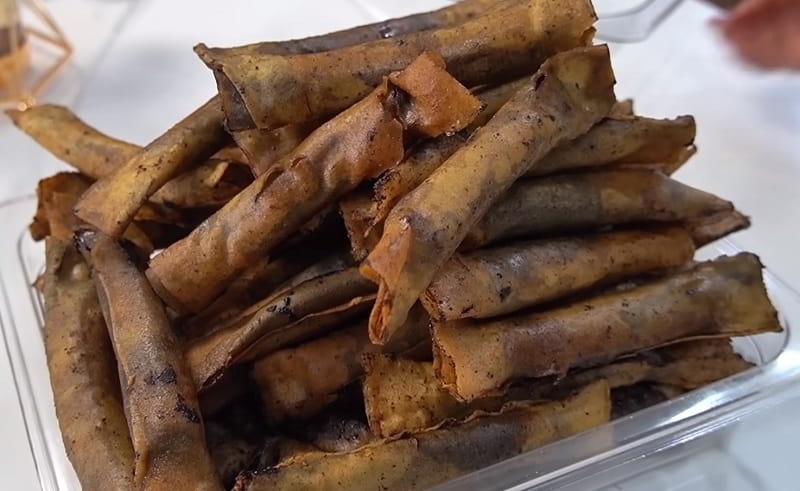
Pisang cokelat, also known as "banana chocolate" in Indonesian or colloquially as piscok, is a delightful Indonesian sweet treat. This snack features slices of banana coated in melted chocolate or chocolate syrup, carefully wrapped in thin pastry skin, and then deep-fried to golden perfection. Often likened to "choco banana spring rolls," pisang cokelat offers a harmonious blend of sweet, fruity banana flavor and rich, indulgent chocolate. The crispy exterior contrasts beautifully with the soft, warm interior, creating a satisfying texture and taste experience. Pisang cokelat is a popular choice among snack enthusiasts in Indonesia, enjoyed for its irresistible combination of flavors and textures. Whether served as a dessert or a special indulgence, pisang cokelat delights taste buds with its comforting sweetness and delightful presentation.
Wingko
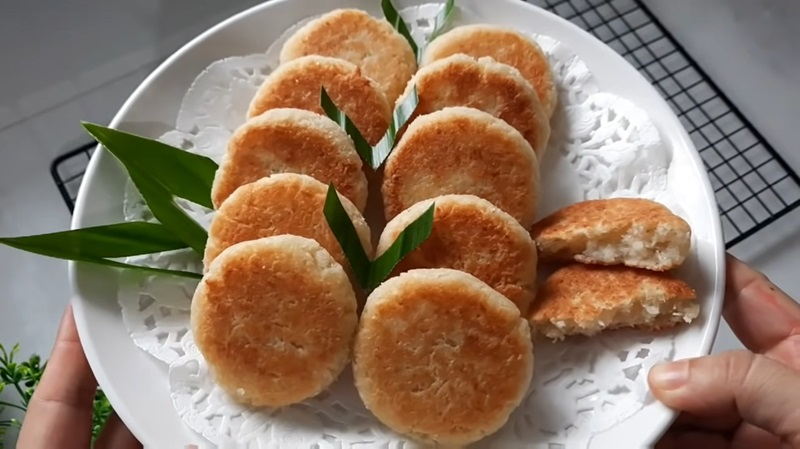
Wingko, also known as Wingko Babat, is a traditional Indonesian cake originating from the Java island, particularly popular in Central Java and East Java provinces. This cake is made from a mixture of glutinous rice flour, grated coconut, coconut milk, sugar, and a pinch of salt. The batter is poured into a circular mold, traditionally made from banana leaves, and then baked until it becomes firm and slightly golden brown on the outside. Wingko has a unique texture, being both dense and chewy, with a slightly crispy crust. It has a rich coconut flavor with a hint of sweetness from the sugar. Wingko is often enjoyed as a snack or dessert, either on its own or accompanied by a cup of tea or coffee. This traditional cake holds a special place in Indonesian culinary culture and is a favorite treat during various festive occasions and celebrations.
Kue Cubit
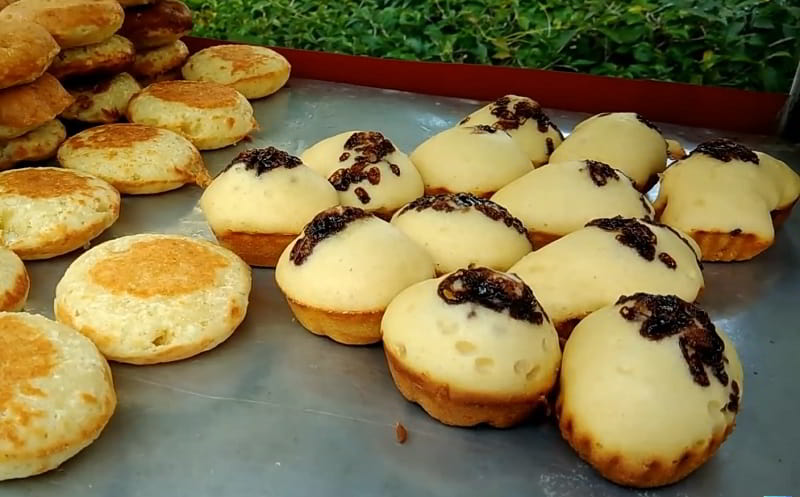
Kue cubit, also known as "pinch cake" in English, is a popular Indonesian snack food that is loved by people of all ages. These bite-sized treats are a delightful combination of fluffy pancakes and sweet toppings, making them a perfect choice for a quick snack or a sweet indulgence. The batter is typically made from a mixture of flour, sugar, eggs, milk, and a touch of vanilla extract for added flavor. Once the batter is mixed, it is poured onto a hot griddle and cooked until golden brown. What makes kue cubit truly special is the variety of toppings that can be added. From chocolate sprinkles and colorful rainbow sprinkles to grated cheese and condensed milk, the options are endless. Each bite-sized cake is then topped with the desired toppings, adding a burst of flavor and texture. Kue cubit is not only delicious but also easy to make, with many street vendors selling them freshly made. They are often enjoyed as a snack during social gatherings, birthday parties, or simply as a tasty treat to satisfy a sweet tooth. These delightful morsels are a must-try for anyone looking to experience the vibrant flavors of Indonesian snack foods.
Kue Talam

Kue Talam, a cherished Indonesian classic, showcases a steamed cake characterized by its distinct two-layer structure. This delectable treat is concocted from a batter typically comprising rice flour, coconut milk, and pandan leaves, infusing it with both a fragrant aroma and a vibrant green hue. The creation of the two layers involves carefully pouring the batter into a mold with segregated compartments—one for the rice flour mixture and the other for a delightful blend of coconut milk and palm sugar. Through the steaming process, the distinct layers take form, with the rice flour layer crowning the top and the sweet coconut and palm sugar mixture forming the bottom. The result is an enticing harmony of textures and flavors, featuring a soft, slightly chewy rice flour layer perfectly complementing the sweet and creamy coconut layer. Kue Talam is a sought-after choice for diverse occasions, serving as a snack, breakfast item, or dessert. Its distinctive appearance and the seamless blend of ingredients have earned it favor among those who appreciate the rich and varied culinary traditions of Indonesia.
Cenil
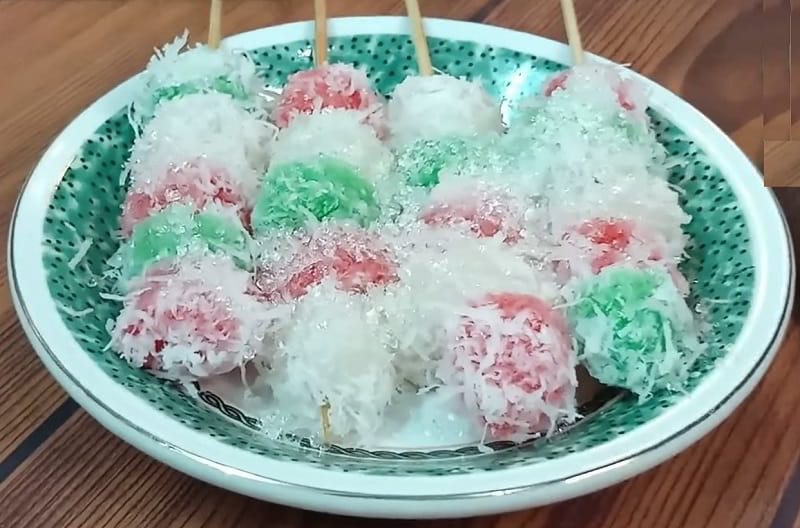
Cenil is a popular Indonesian snack food that is loved by people of all ages. It is a sweet and chewy dish that is made from tapioca flour and grated coconut. The dough is made by mixing tapioca flour with water and then shaping it into small balls. These balls are then boiled until they become soft and chewy. Once cooked, the cenil balls are coated with grated coconut to give them a deliciously sweet and nutty flavor. Some variations of cenil also include a mixture of palm sugar or pandan leaves to add a hint of sweetness and aroma. Cenil is not only delicious but also visually appealing. The small and colorful balls make for an attractive presentation, making it a popular choice for special occasions or as a dessert to be served after meals. Whether enjoyed on its own or as a topping for other desserts, cenil is a delightful treat that will surely satisfy your sweet tooth. Its soft and chewy texture combined with the subtle flavors of coconut and palm sugar make it a truly irresistible Indonesian snack food.
Kue Ape
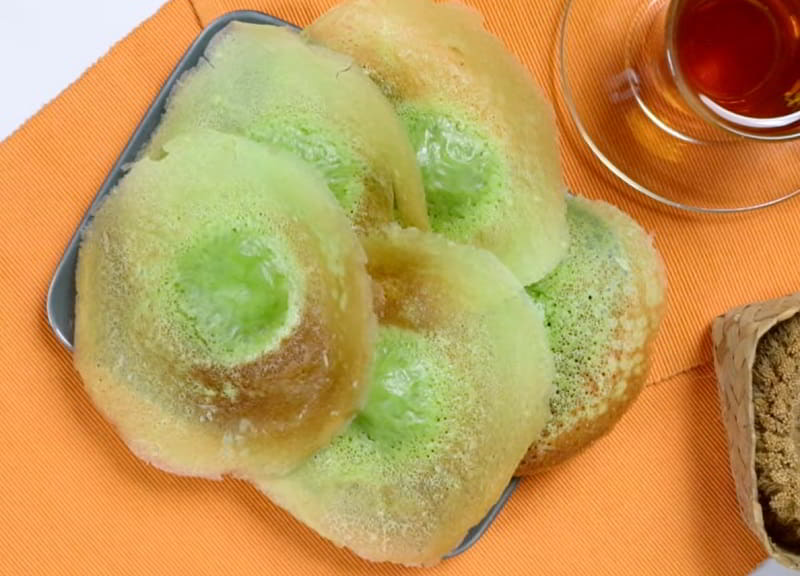
Kue ape, also known as kue apem or kue apam, is a popular Indonesian snack food that is loved by people of all ages. This delightful dish is made from a batter consisting of rice flour, coconut milk, yeast, sugar, and water. The batter is then poured into small molds and cooked until it becomes fluffy and slightly crispy on the outside. Kue ape is often enjoyed as a snack or dessert, and it is commonly found in traditional markets and street food stalls across Indonesia. Some variations even include toppings like grated coconut or sliced bananas to enhance the taste and texture. The texture of kue ape is soft and chewy, and it has a subtle sweetness that is not overpowering. The combination of coconut milk and rice flour gives it a rich and creamy flavor. It is best enjoyed when freshly made and still warm. Whether you are a local or a visitor to Indonesia, kue ape is a must-try snack that will surely satisfy your cravings for something sweet and delightful.
Kue Bingka
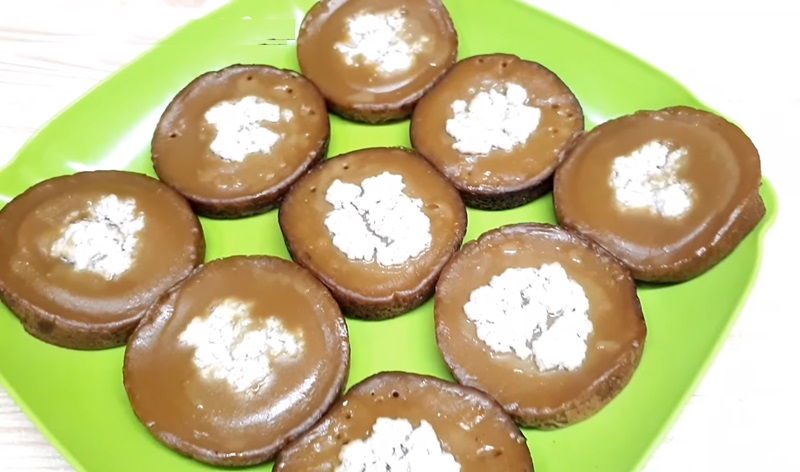
Kue Bingka stands as a cherished Indonesian traditional cake, particularly associated with the Banjar culinary tradition of South Kalimantan province. This delightful cake is crafted from a blend of flour, eggs, coconut milk, sugar, and salt, creating a rich and flavorful batter. Traditionally, Kue Bingka is baked with intricate floral patterns, adding to its visual appeal. There are several variations of Kue Bingka, including those made with tapai (fermented cassava), potato, pumpkin, and pandan, each offering unique flavors and textures. During Ramadan, a special variation known as "kue bingka barandam" emerges, differing significantly from the traditional version. This diverse array of Kue Bingka reflects the richness of Indonesian culinary heritage, offering a delightful taste of tradition and culture with every bite.
Bakpau
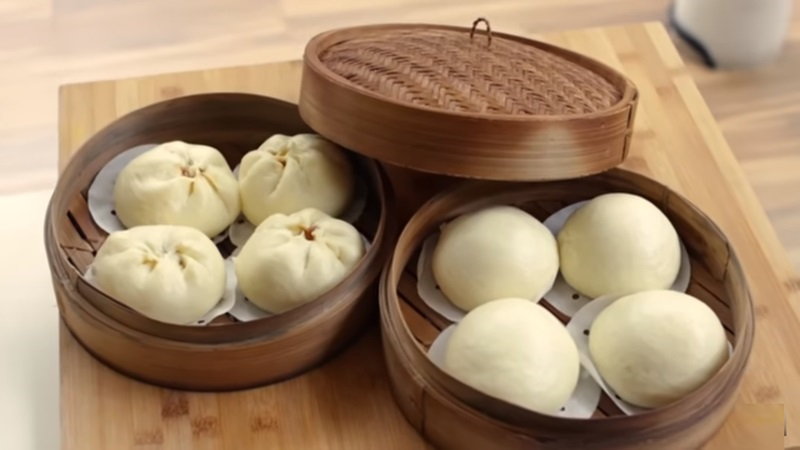
Bakpau is a popular Indonesian snack that has gained immense popularity both within the country and abroad. It is a delicious dish that consists of a steamed bun filled with a variety of mouthwatering fillings. The bun itself is soft and fluffy, made from wheat flour and yeast, giving it a slightly sweet and chewy texture. The fillings of Bakpau can vary, offering a wide range of options to suit different palates. Some common fillings include savory ingredients like pork, chicken, shrimp, or vegetables, mixed with flavorful spices and sauces. There are also sweet variations, filled with ingredients like red bean paste or peanuts. The beauty of Bakpau lies in its versatility and adaptability. It can be enjoyed as a quick snack on the go or as a satisfying meal when paired with a side dish. The softness of the bun complements the savory or sweet fillings, creating a delightful combination of flavors. Bakpau is not only delicious but also a convenient snack option. It is easily available in various street food stalls, and restaurants, and even sold frozen in supermarkets, making it accessible to people from all walks of life. Its popularity is a testament to its irresistible taste and cultural significance in Indonesian cuisine.
Kue Semprong
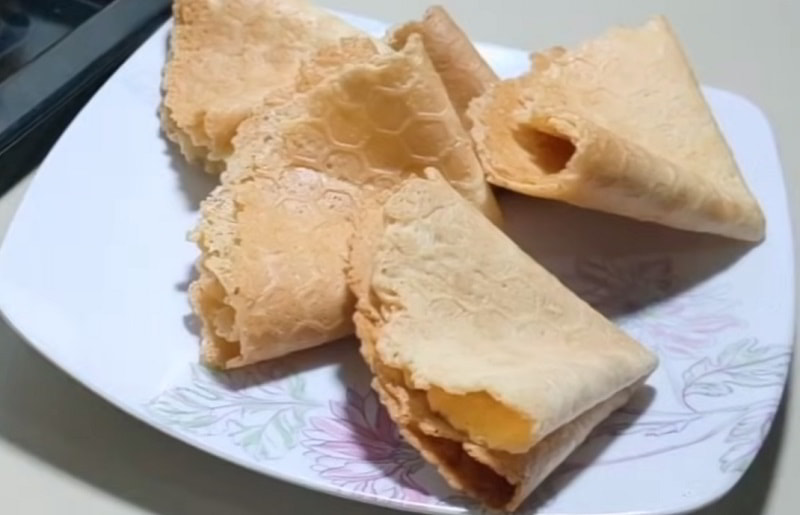
Kue semprong, also known as "love letters" or "kue kapit," is a popular Indonesian snack that is loved by people of all ages. This traditional delicacy is made from a simple batter consisting of flour, sugar, coconut milk, and eggs. The batter is then poured onto a special iron mold and cooked until it becomes crispy and golden brown. The resulting snack is a thin and delicate wafer-like treat, with a beautiful lattice pattern that resembles a love letter. Kue semprong has a sweet and fragrant flavor, with a hint of coconut. It is often enjoyed on its own as a snack or paired with a cup of tea or coffee. Kue semprong is commonly found in traditional markets, street food stalls, and even in households during festive occasions such as Chinese New Year. It is a symbol of happiness, prosperity, and good fortune. This snack is not only delicious but also visually appealing, making it a perfect gift or treat for special occasions. In summary, kue semprong is a beloved Indonesian snack with its thin and crispy texture, sweet coconut flavor, and beautiful lattice pattern. It is a delightful treat that brings joy and happiness to those who savor it.
Seri Muka

Seri Muka is a traditional Indonesian snack that is well-loved for its unique combination of flavors and textures. This delightful treat consists of two layers: a sticky rice layer at the bottom and a rich, creamy pandan-flavored custard layer on top. The bottom layer is made from glutinous rice that has been soaked and steamed until perfectly cooked. It has a slightly chewy texture and a subtle sweetness that complements the creamy custard layer. The top layer is made from a mixture of eggs, coconut milk, pandan juice, and sugar. The pandan juice gives it a vibrant green color and a fragrant aroma that is both refreshing and enticing. Seri Muka is often served as a snack or dessert during special occasions, such as weddings or religious ceremonies. It is also commonly found in local markets and food stalls, where it is sold in bite-sized pieces. The combination of the soft and sticky rice layer with the smooth and creamy custard layer creates a delightful contrast of textures that is truly addictive. Whether enjoyed as a sweet treat on its own or paired with a cup of hot tea, Seri Muka is a beloved Indonesian snack that is sure to leave you craving more.
Clorot
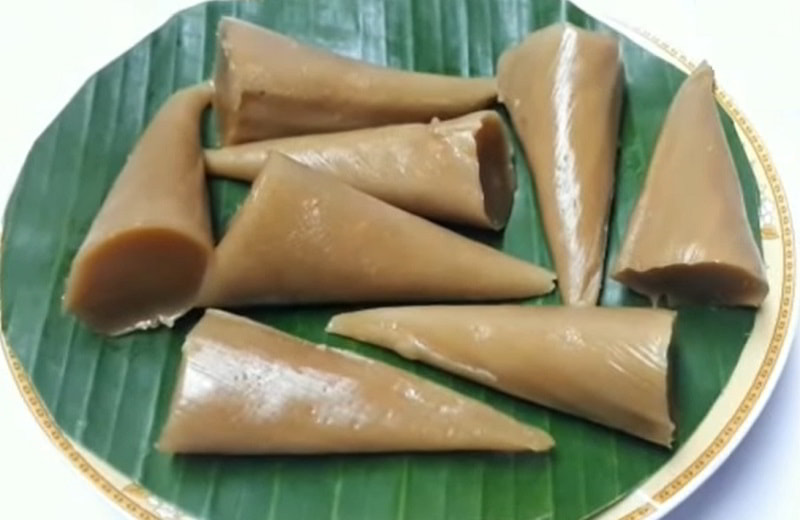
Clorot stands as a cherished traditional delicacy in Indonesia, skillfully prepared by combining sweet and tender rice flour cake with coconut milk, enclosed in cone-shaped casings crafted from janur or young coconut leaves. This delectable treat has not only earned popularity in Indonesia but has also become well-loved in Brunei and Malaysia. The clorot preparation involves boiling a blend of palm sugar, pandan leaf, salt, and water until fully cooked. This sweetened mixture is then combined with rice flour and sago or tapioca flour, forming a thick, sweet liquid. Meticulously shaped into elongated cones resembling petite trumpets, the janur or young coconut leaves are securely fastened and positioned upright. The dense, sweet batter is poured into these coconut leaf cones until three-quarters full, and the apex of each cone is filled with a mixture of coconut milk, rice flour, and salt. Following this, the filled cones undergo steaming for approximately 15 minutes, allowing the dough to cook and solidify, resulting in the delightful clorot.
Kue Mangkok
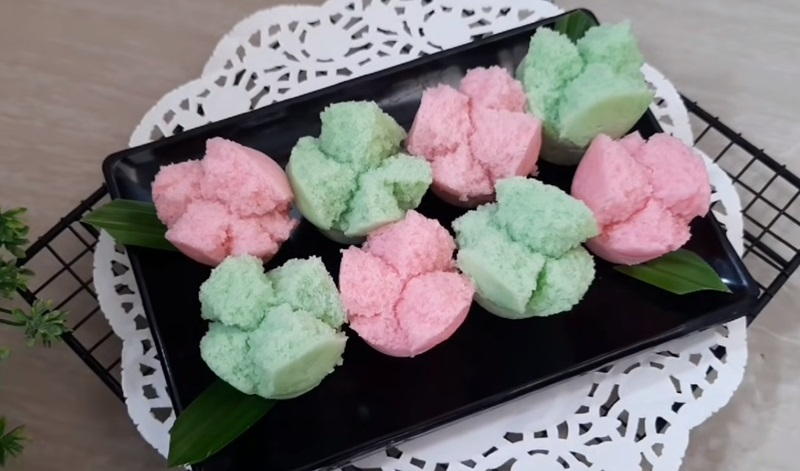
Kue mangkok, an Indonesian traditional snack, is a delightful steamed cupcake known for its unique cup-like shape. Made from a mixture of flour, sugar, coconut milk, rice flour, tapioca, yeast, egg, and salt, its dough offers a rich and flavorful base. Traditional versions are often sweetened with palm sugar, resulting in a distinctive brown hue. Variations may incorporate tape singkong (fermented cassava), sweet potato, or taro for added flavor and texture diversity. The dough is carefully placed into tin or stainless steel cupcake containers (although, small bowls can also be used), then steamed until the cakes rise and bloom like flowers, forming four petal-like lumps on top. With a texture that is soft, firm, and slightly moist, kue mangkok offers a unique eating experience. To enhance its taste, grated coconut is sometimes sprinkled on top. Kue mangkok is a beloved Indonesian treat, enjoyed for its delightful flavors and charming presentation.
Kue Bolu

Kue bolu is a popular Indonesian snack food that is loved by people of all ages. It is a type of cake that is known for its soft and fluffy texture, making it a delightful treat to enjoy with a cup of tea or coffee. The main ingredients used in kue bolu are flour, sugar, eggs, and butter. These simple ingredients are mixed together to create a smooth batter, which is then poured into molds and baked until golden brown. The result is a light and airy cake that melts in your mouth. Kue bolu comes in various flavors, such as chocolate, vanilla, and pandan. It can also be filled with fruits, nuts, or cream for added taste and texture. The cakes are often topped with powdered sugar or a glaze to enhance their appearance. Kue bolu is commonly enjoyed during special occasions and celebrations, but it is also a popular snack to have on a regular day. It is often sold by street vendors or in local bakeries, where it is freshly made and served warm. Whether you have a sweet tooth or simply enjoy indulging in tasty treats, kue bolu is sure to satisfy your cravings. Its light and fluffy texture, combined with its delicious flavors, make it a beloved snack food in Indonesian cuisine.
Lumpia Semarang
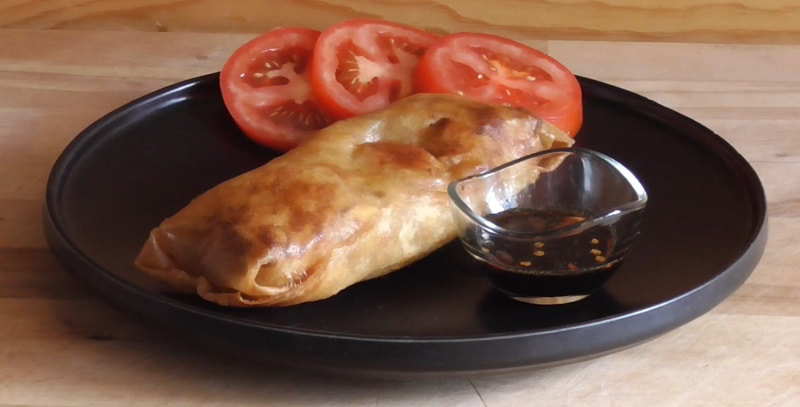
Lumpia Semarang is a popular Indonesian snack that originated from the city of Semarang in Central Java. It is a type of spring roll that is filled with various ingredients, typically including egg, shrimp, bamboo shoots, chicken, carrots, and bean sprouts. The filling is stir-fried with a combination of spices and then wrapped in a thin pastry wrapper made from flour and water. Once the filling is wrapped, the lumpia is deep-fried until golden and crispy. It is commonly served with a sweet and tangy dipping sauce made from vinegar, garlic, sugar, and chili flakes. The combination of the crunchy exterior and the flavorful filling makes Lumpia Semarang a delightfully satisfying snack. Lumpia Semarang is loved for its versatility and can be enjoyed as an appetizer, snack, or even as a main dish when served with rice. It is often found in street food stalls, markets, and Indonesian restaurants, where it is freshly made and served hot. With its delicious taste and crispy texture, Lumpia Semarang has become a beloved snack food in Indonesia and has gained popularity beyond its place of origin.
Kue Rangi
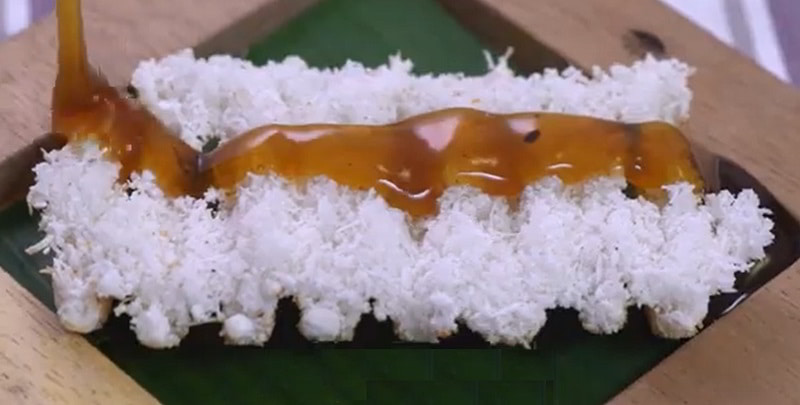
Kue rangi, also recognized as sagu rangi, epitomizes a traditional Indonesian coconut kue or snack meticulously fashioned from a harmonious blend of coconut and starch. Originating in Jakarta as an intrinsic facet of Betawi's traditional snacks, it frequently draws comparisons to an Indonesian coconut waffle. The distinctive mold pan, reminiscent of a muffin tin but featuring rectangular basins instead of rounded ones, imparts a unique half-moon or boat-shaped appearance to the cakes. This specialized grill-like metal mold, employed for kue rangi, finds utility in other traditional Indonesian kue such as kue pancong and kue pukis. Notably, the mold pan for kue rangi has smaller basin tubs, leading to cakes that adhere together, resembling waffles. The batter is a fusion of tapioca starch (referred to as sago flour by the Betawi people), grated coconut, salt, and water. Poured onto a distinctive metal mold and baked on a small stove, kue rangi acquires a drier texture compared to coconut kue pancong with a similar shape. Paired with a sumptuous drizzle of liquid brown sugar or coconut sugar sauce, thickened subtly with starch, kue rangi features a dense, slightly runny, gelatinized sweet brown sauce. To elevate its aromatic allure, this sweet infusion occasionally incorporates morsels of jackfruit, pineapple, or a hint of pandan leaf. In the traditional method, kue rangi undergoes baking over a wood-fueled stove, imparting a delightful smoky aroma to the freshly crafted delicacies.
Kue Putri Salju
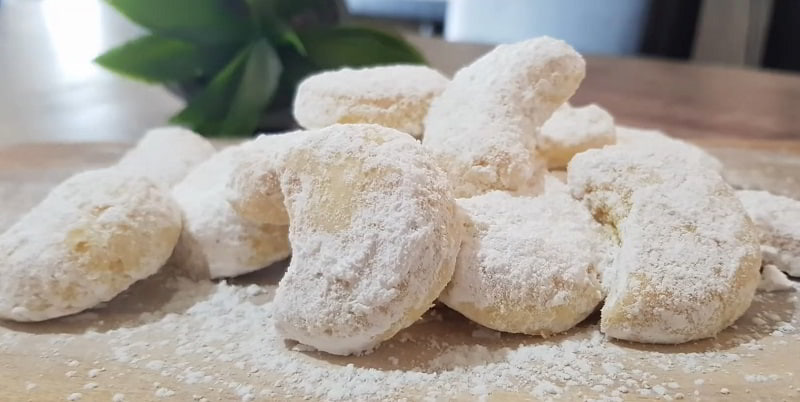
Putri Salju is an Indonesian snack cookie renowned for its crescent shape and a delightful covering of powdered sugar. Translating to "snow princess" in Indonesian, the name aptly captures the essence of the powdered sugar coating, resembling a layer of snow. The cookie dough consists of a delicate blend of flour, cornstarch, butter or margarine, and egg yolks, baked to perfection in the oven. Once the cookies are done, they undergo a gradual cooling process to reach room temperature. After cooling, powdered sugar is either delicately sprinkled onto the cookies or, alternatively, both the sugar and cookies are placed in a plastic bag and gently shaken to evenly distribute the sugar across the surfaces of the cookies. It's essential to store the prepared cookies in airtight containers to prevent the sugar from absorbing moisture through hygroscopy. Widely adored by the Indonesian people, particularly children, Putri Salju has evolved with various versions, including cheese, chocolate, and a popular pandan-flavored variant prepared with green food coloring.
Kue Lidah Kucing
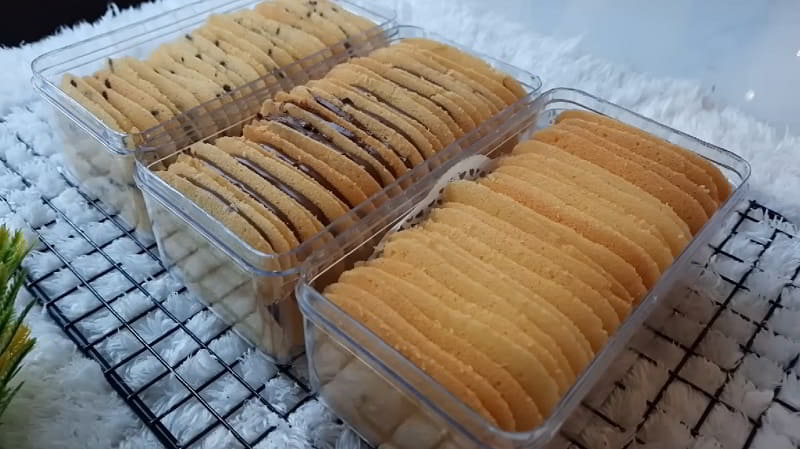
Kue lidah kucing, also known as cat's tongue kue', is a popular Indonesian snack that is loved by both locals and visitors alike. These delicate, bite-sized cookies are named after their thin and elongated shape, resembling a cat's tongue. Made from a simple blend of flour, butter, sugar, and eggs, kue lidah kucing has a light and crispy texture that melts in your mouth. The cookies are often flavored with vanilla or chocolate, giving them a subtle yet delightful taste. Kue lidah kucing is commonly enjoyed with a cup of tea or coffee, making it a perfect companion for a relaxing afternoon break. It is also frequently served during special occasions such as weddings, birthdays, and holidays as a sweet treat for guests. With its appealing appearance and delightful taste, kue lidah kucing has become a staple in Indonesian snack food culture. It is often found in local markets, bakeries, and snack stalls across the country, offering a delicious and satisfying snack option for those with a sweet tooth.
Kue Bangkit
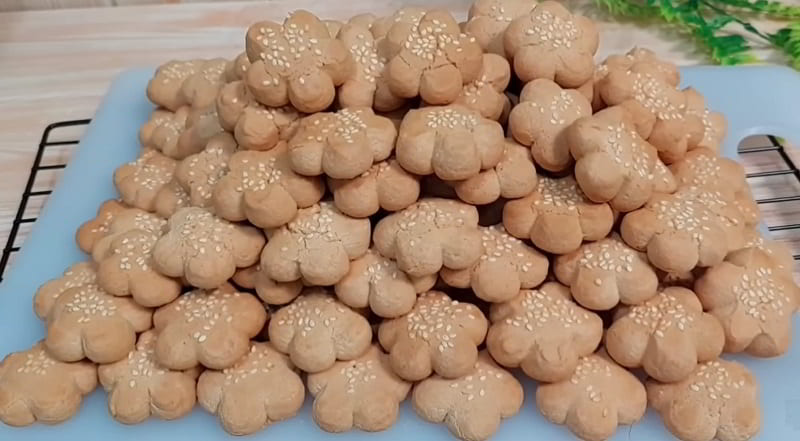
Kue Bangkit is a cherished traditional Indonesian biscuit that holds cultural significance in Malay communities across Brunei, Indonesia, Malaysia, and Singapore. These intricately crafted small biscuits are renowned for their visual diversity, presenting colors from white to yellowish or brown, influenced by ingredients like tapioca starch, coconut milk, sugar, pandan leaf, margarine, egg yolks, and salt. Occasionally, additional elements like vanilla extract and gula aren (palm sugar) are added for an enhanced flavor profile. The biscuit's texture is characterized by a crisp and delicate nature, achieved through careful shaping with small cookie molds before baking in the oven. The unique joy of savoring Kue Bangkit lies in its seamless dissolution in the mouth while maintaining a satisfying crispiness during chewing. This delectable treat skillfully blends sweet and savory flavors, serving as a testament to its status as a beloved delicacy deeply embedded in the culinary heritage of the Malay communities, where it continues to be a symbol of tradition and cultural pride.
Kue Bugis
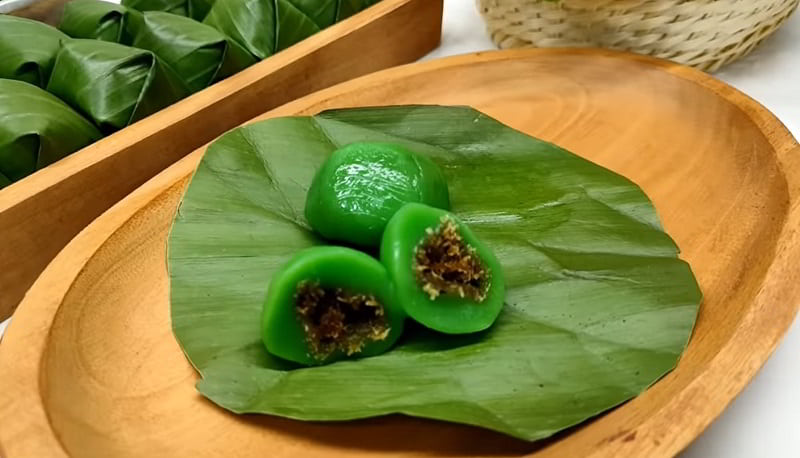
Kue Bugis, a cherished Indonesian traditional snack, features a soft glutinous rice flour cake filled with sweet grated coconut. Its outer layer combines glutinous rice flour, wheat flour, mashed potatoes, coconut milk (santan), sugar, and salt, colored with suji or pandan for a green tint. The filling boasts grated coconut sweetened with palm sugar, seasoned with a touch of salt, and scented with pandan leaf. Traditionally, Kue Bugis is enveloped in young banana leaves, imparting a delicate aroma. However, modern versions may opt for plastic wrappers. This beloved treat embodies the essence of Indonesian culinary heritage, celebrated for its distinct flavors and cultural significance.
Gethuk
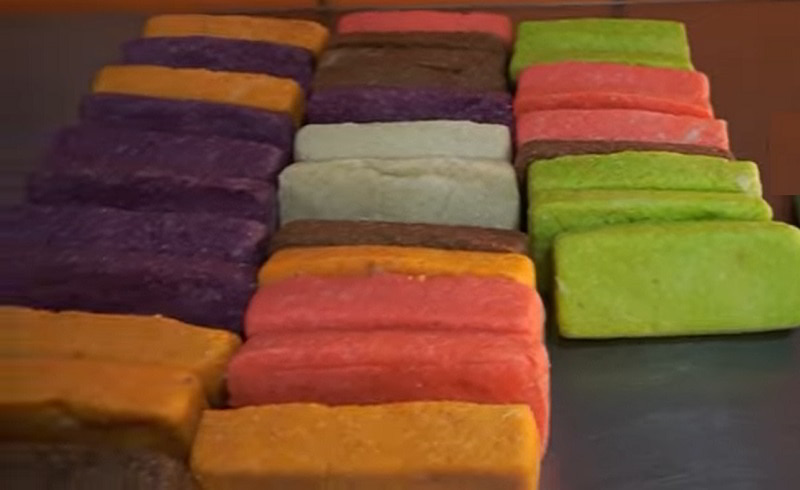
Gethuk is an Indonesian snack made from cassava or sweet potatoes. It is a popular dish in the Central Java and Yogyakarta regions of Indonesia. Gethuk is loved for its chewy texture and sweet taste, making it a delightful treat for both kids and adults. To make Gethuk, the cassava or sweet potatoes are first cooked and then mashed into a smooth paste. Palm sugar is added to give it a sweet flavor, and sometimes grated coconut is mixed in for added richness. The mixture is then shaped into small bite-sized pieces, often resembling a small ball or cylindrical shape. Gethuk can be enjoyed on its own or paired with a cup of hot tea or coffee. It is commonly served during special occasions such as weddings, festivals, and religious ceremonies. This snack is not only delicious but also a great source of energy due to its high carbohydrate content. Whether you're a fan of sweet treats or curious about Indonesian cuisine, Gethuk is definitely worth a try. Its unique taste and texture will surely leave you wanting more.
Kue Kembang Goyang
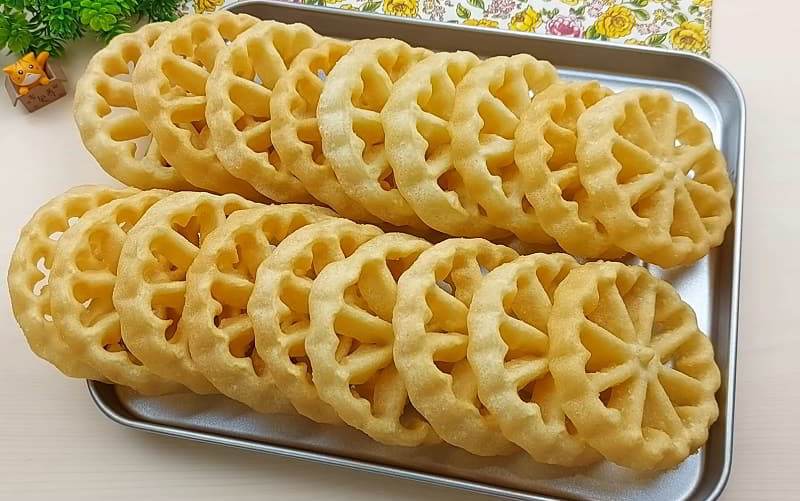
Kue kembang goyang is a traditional Indonesian snack that is loved by many. It is a sweet and crispy delicacy that is commonly enjoyed during festive occasions and as an afternoon snack. The name "kue kembang goyang" translates to "shaking flower cake" in English, which refers to the unique shape of the snack. It is made from a simple batter that is deep-fried until it becomes golden brown and crispy. The batter is poured into a special mold with a long handle, and then shaken back and forth to create a flower-like shape. The texture of kue kembang goyang is light and crunchy, making it a satisfying treat for snack lovers. It has a slightly sweet taste, with hints of coconut and palm sugar. Some variations of the snack may also include pandan or vanilla flavorings to add a delightful aroma. Kue kembang goyang is often served with a cup of hot tea or coffee, making it a perfect companion for a relaxing afternoon break. Its unique shape and delicious taste make it a popular choice for special occasions and as a beloved snack throughout Indonesia.
Madumongso
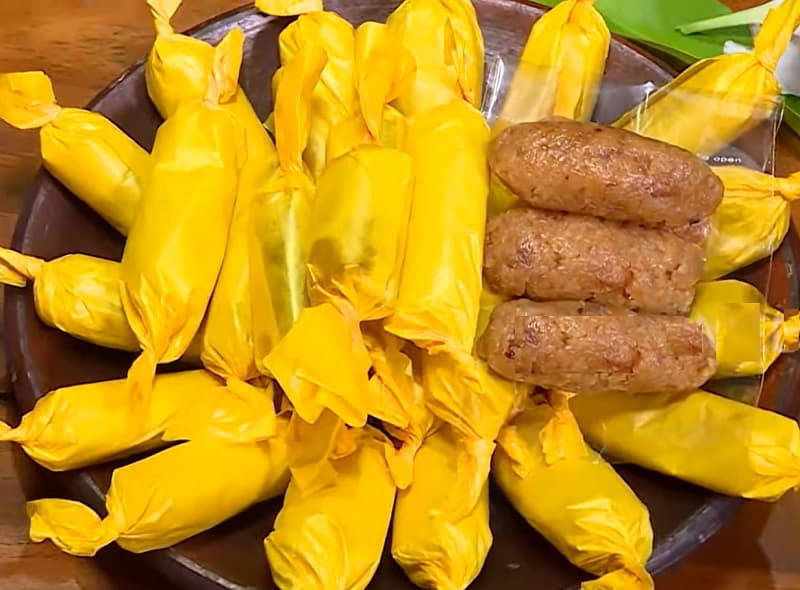
Madumongso, also known as madumangsa, stands as a distinctive Javanese delicacy crafted from black sticky rice as its primary ingredient. The unique flavor profile of this snack is a harmonious blend of sweetness, owing to the meticulous preparation of the black rice. Before being used in madumongso, the black rice undergoes a transformative process, fermented to produce tapai and subsequently cooked to create dodol. Hailing from the picturesque region of Ponorogo in East Java, madumongso embodies the rich culinary heritage of the area. The artful combination of fermented black rice and the cooking process results in a snack that not only tantalizes the taste buds with its sweet notes but also carries the distinct cultural imprint of Javanese culinary traditions. As a testament to its origin, madumongso reflects the culinary craftsmanship that has been passed down through generations in Ponorogo, contributing to the cultural tapestry of East Java. Enjoyed for its unique texture and delightful sweetness, madumongso remains a local delicacy that showcases the cultural pride and gastronomic creativity of the Javanese people.
Kue Putu Mayang
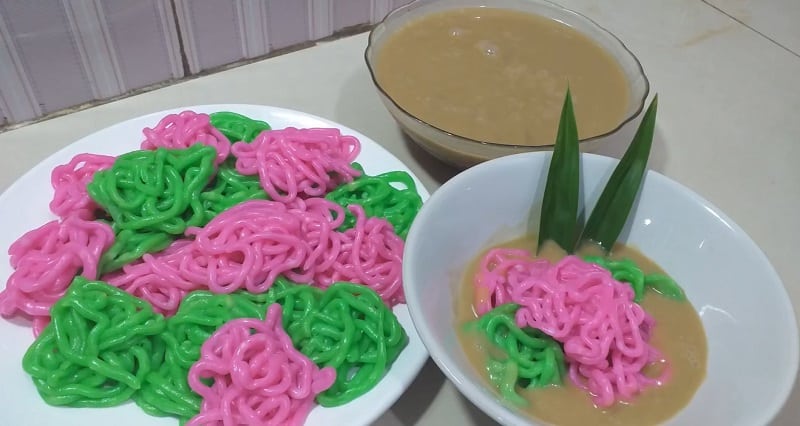
Kue putu mayang, an Indonesian Betawi culinary delight, is a string hopper dish that showcases a meticulous combination of starch or rice flour and coconut milk, resulting in noodle-shaped strands. This unique creation is distinguished by its versatile serving options across different culinary traditions. In Betawi and Javanese cuisine, kue putu mayang is typically served with kinca, a liquid palm sugar concoction, imparting a delightful sweetness to the dish. On the other hand, in Indian Indonesian cuisine, this noodle-like delicacy finds itself accompanied by chutney or curry, adding a savory dimension to its flavor profile. The artful preparation of kue putu mayang exemplifies the culinary creativity inherent in Indonesian Betawi traditions, showcasing the harmonious blend of diverse ingredients. Its adaptability across various regional cuisines further highlights its cultural significance and versatility in satisfying different palate preferences. Whether enjoyed with the sweetness of kinca or the savory allure of chutney and curry, kue putu mayang stands as a testament to the rich culinary heritage of Indonesia, where culinary traditions and flavors converge to create delightful and diverse gastronomic experiences.
Kue Satu
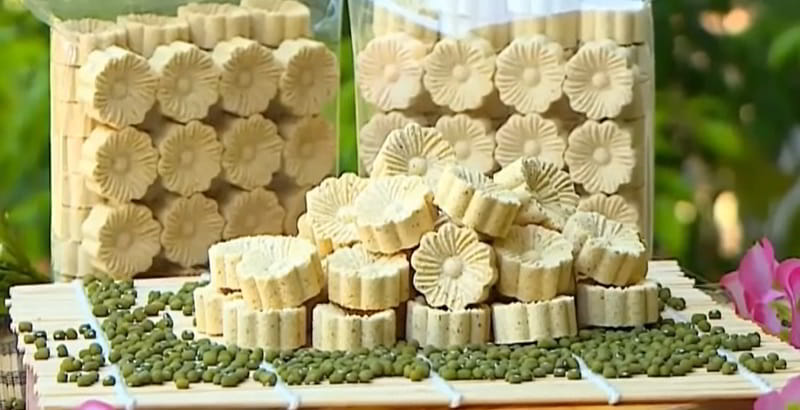
Kue Satu, known as Kue Koya in Central and East Java, is a beloved traditional dry cookie popular across Indonesia. Made from sweet white mung bean powder, it crumbles delicately upon each bite. With just four simple ingredients—mung beans, powdered sugar, vanilla extract, and water—these cookies encapsulate simplicity and flavor. The process begins by dry-toasting mung beans until their skins crack and are then peeled off. The beans are then manually mashed or ground, combined with powdered sugar, vanilla extract, and a touch of water to form a dough. Shaped into small cookies, they are baked at 150°C, then air-dried in the sun for several hours to achieve the perfect texture. Finally, these delightful treats are stored in airtight containers, preserving their freshness. Kue Satu symbolizes the essence of Indonesian culinary tradition, cherished for its humble ingredients and delightful taste.
Roti Bolen
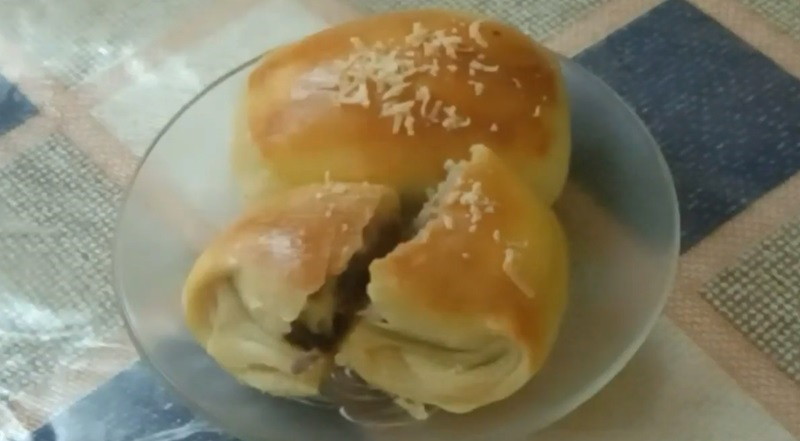
Roti Bolen, an Indonesian baked bread pastry, showcases a unique fusion of flavors and textures, reminiscent of European pastry influences. The pastry features layers in its crust that resemble the flakiness of croissants, achieved by incorporating butter or margarine into the flour. This delectable creation is not only a treat for the senses but also a testament to the culinary diversity found in Indonesian cuisine. The filling of Roti Bolen is a delightful combination of cheese and banana, creating a harmonious blend of savory and sweet notes. The inclusion of these ingredients adds a rich and creamy texture to the pastry, making it a beloved choice among those with a sweet tooth. For those seeking a more adventurous palate experience, variations of Roti Bolen with durian fillings are also available. Roti Bolen's adaptation of European pastry techniques and its incorporation of local Indonesian flavors results in a pastry that bridges cultural influences. Whether enjoyed as a snack or dessert, this pastry has become a symbol of the culinary creativity found in Indonesia, where traditional and international flavors come together in a delightful harmony.
Kue Gapit
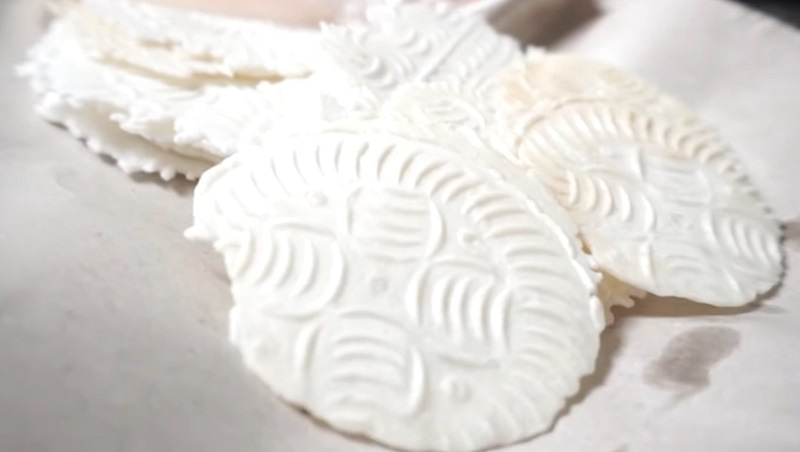
Originating from West Java, Kue Gapit is a cherished traditional Indonesian snack. Its ingredients typically comprise wheat, rice flour, eggs, coconut water, salt, sugar, and cinnamon. The preparation involves beating eggs, then combining them with cinnamon and sugar until absorbed. Flour and salt are added to the mixture, followed by coconut water, creating a smooth batter. A tablespoon of the batter is poured into iron molds and grilled until cooked, repeating the process until all the batter is used. While some recipes use tapioca instead of the mix of flours, the outcome remains a delightful crispy treat. Kue Gapit can be enjoyed either on its own or served as a delectable side dish, embodying the rich culinary heritage of Indonesia.
Jipang
-1708397825.jpg)
Jipang, also known as Jipang Jagung or Jipang Kacang, is a traditional Indonesian snack made from popped rice coated in melted palm sugar or caramelized sugar syrup. To make Jipang, the rice is first heated until it pops, similar to making popcorn. Once popped, they are then coated in a sticky mixture of palm sugar or caramelized sugar syrup, which adds a sweet and crunchy outer layer. Jipang is often enjoyed as a snack on its own, and it's commonly found in traditional markets, street food stalls, and during festive occasions. Its sweet and crispy texture makes it a favorite among Indonesians of all ages. In addition to being a delicious snack, Jipang also holds cultural significance and is often served during traditional ceremonies and celebrations as a symbol of joy and abundance.
Yi Bua
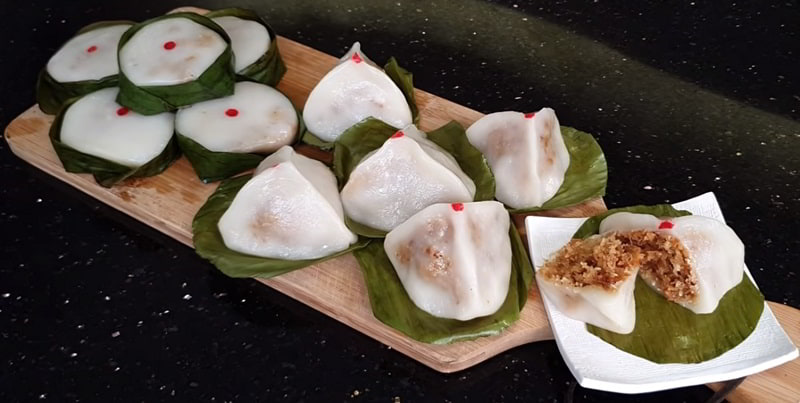
Yi Bua, a beloved traditional Hainanese kuih embraced in Indonesia, is a steamed dumpling crafted from glutinous rice flour dough. Also referred to as kuih e-oua, it features a delectable filling composed of toasted sesame seeds, grated coconut, and crushed roasted peanuts sweetened with palm sugar. These flavorful ingredients are carefully encased in sheets of banana leaves, meticulously pressed into a distinctive fluted cup shape. As a final touch, a dab of red food coloring is often added for a traditional touch. Yi Bua delights taste buds with its sweet and nutty flavor profile, paired with the comforting texture of the glutinous rice dough. This cherished treat is not only enjoyed for its delicious taste but also holds cultural significance, representing the culinary diversity and heritage of Indonesia.
Sumpia
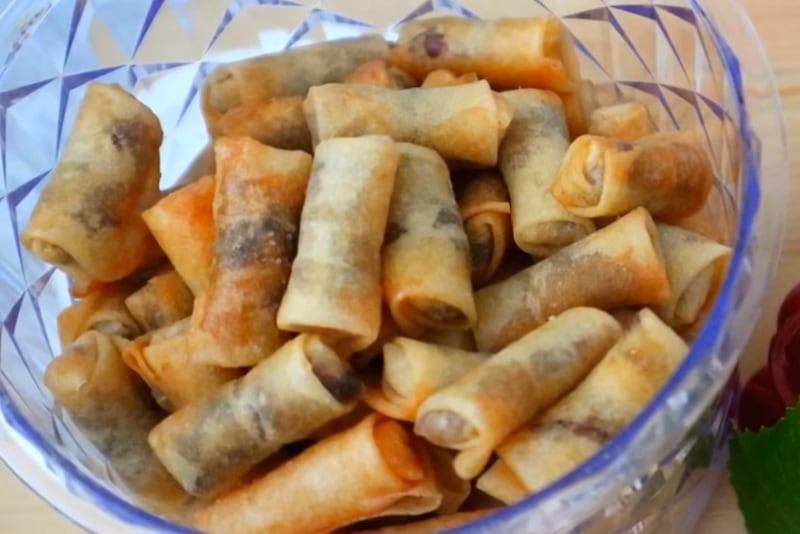
Sumpia, a popular Indonesian snack, is a delectable dish that is loved by locals and tourists alike. It is a type of spring roll that is filled with a variety of flavorful ingredients. The dish originated from the Chinese influence in Indonesian cuisine but has evolved to have its own unique Indonesian twist. The filling of Sumpia typically consists of a mixture of vegetables, such as carrots, cabbage, and bean sprouts, combined with savory meats like chicken, shrimp, or minced pork. These ingredients are seasoned with various spices like garlic, ginger, and soy sauce, giving the filling a burst of aromatic flavors. The spring roll wrappers are made from a thin, crispy pastry that is fried to perfection, resulting in a delightful crunch with every bite. Sumpia is often served with a sweet and tangy dipping sauce, enhancing the overall taste experience. Whether enjoyed as a quick snack or as part of a larger meal, Sumpia is a versatile dish that can be found in street food stalls, local markets, and even high-end restaurants across Indonesia. Its delicious combination of textures and flavors make it a must-try for anyone looking to explore the rich culinary heritage of the country.
Kue Makmur
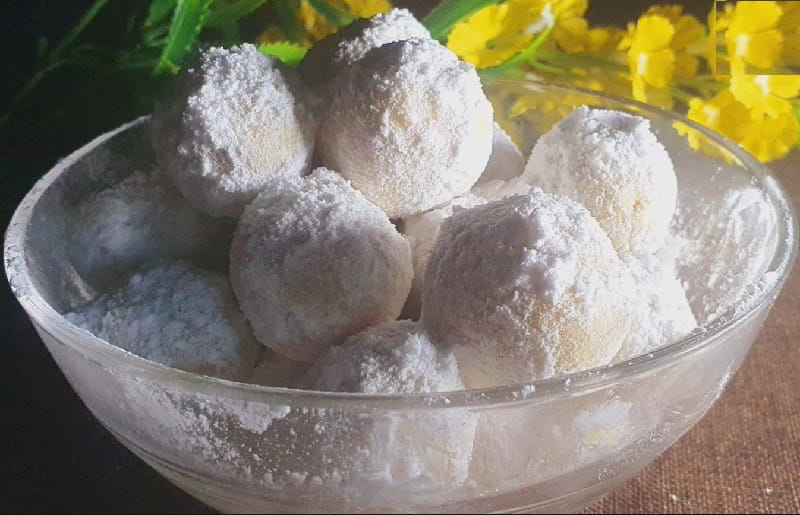
Kue Makmur, a cherished traditional Malay delicacy adored in Indonesia, is a sought-after treat typically enjoyed during the month-long Ramadan and served to guests for Eid al-Fitr celebrations. These delightful kue are crafted from powdered nuts, ghee, flour, and icing sugar, resulting in a delectable blend of flavors and textures. Their availability is often limited to the bustling bazaars of Ramadan, adding to their allure and special significance during festive occasions. Kue Makmur is easily recognized by its distinctive round shape and white color, which adds to its visual appeal. With its rich nutty flavor and delicate sweetness, this beloved treat symbolizes the joy and togetherness shared during Eid al-Fitr celebrations, making it a cherished part of Indonesian culinary traditions.
Timphan
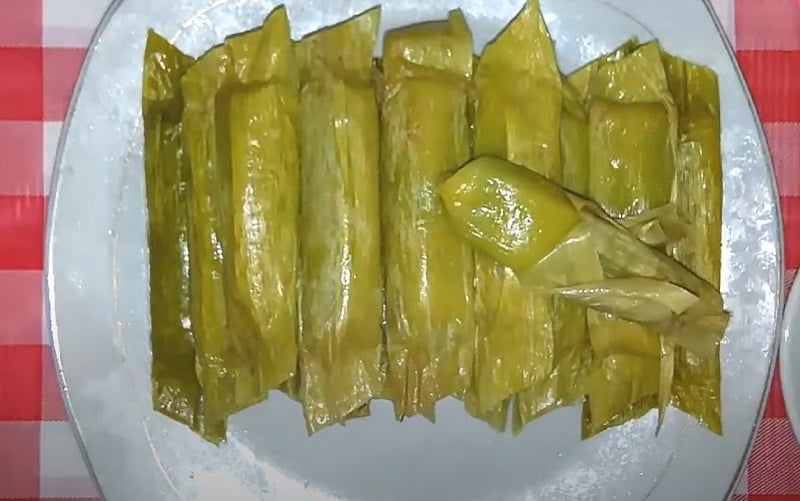
Timphan, also referred to as timpan, emerges as a steamed banana dumpling with its roots in Aceh, Indonesia. This traditional kue, or sweet snack, is frequently savored during special occasions, especially during Eid and other festive events. Crafting timphan involves skillfully combining glutinous rice flour, ground banana, and coconut milk, resulting in a thick and dough-like consistency. The banana-infused rice flour dough is thoughtfully spread lengthwise, serving as a foundation for the delectable filling. Typically, the filling comprises sweetened serikaya or grated coconut mixed with sugar, introducing layers of sweetness and flavor to the dumpling. The entire assembly is then carefully enveloped in banana leaves and subjected to steaming for approximately an hour. A noteworthy distinction between timphan and another popular Indonesian kue, nagasari, lies in their fillings. While nagasari incorporates slices of banana, timphan boasts a sweet grated coconut filling, seamlessly integrating the banana into the dough itself. This subtle yet significant variation contributes to the diverse array of flavors and textures found in Indonesian kue, exemplifying the culinary richness of the region. Timphan holds cultural significance, often being a delightful treat shared during communal celebrations in Aceh.
Lumpia Goreng
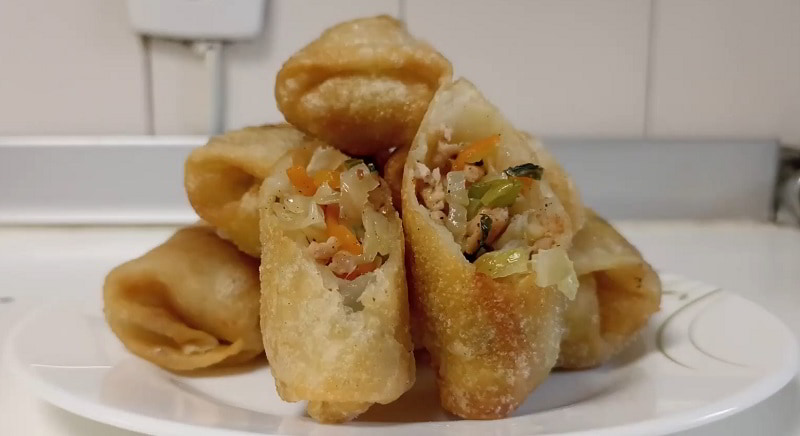
Lumpia goreng is a popular Indonesian snack that is loved by locals and visitors alike. This delicious dish is essentially a type of spring roll that is deep-fried to perfection. The filling of lumpia goreng can vary, but it typically consists of a savory mixture of vegetables, such as cabbage, carrots, and bean sprouts, along with minced meats like chicken, shrimp, or pork. The spring roll wrappers used for lumpia goreng are thin and crispy, providing a delightful texture contrast to the flavorful filling. These rolls are usually served with a tangy dipping sauce, which adds a burst of additional flavor. Lumpia goreng is often enjoyed as a street food snack, and it is commonly found in local markets and food stalls throughout Indonesia. Its popularity can be attributed to its delicious taste, affordability, and portability. Whether you're exploring the bustling streets of Jakarta or relaxing on a beach in Bali, you're likely to come across this delightful snack. Overall, lumpia goreng is a must-try Indonesian snack food, offering a delightful combination of crispy texture and savory flavors that will leave you wanting more.
Kue Asida
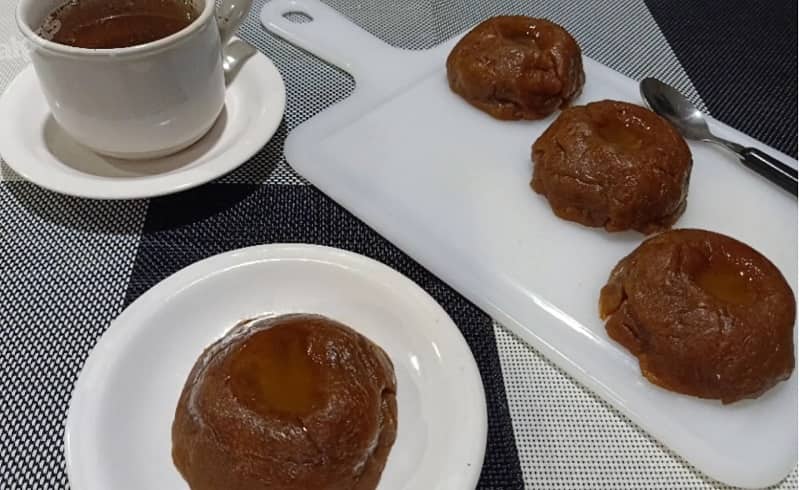
Kue asida, a delightful Indonesian pudding dessert, is skillfully crafted from a blend of water, cinnamon, butter, honey, sugar, wheat flour, and cardamom. This sweet delicacy holds a special place in Moluccan cuisine and is equally revered in Malay Indonesian and Arab Indonesian culinary traditions. Its significance is particularly pronounced during Ramadan, where it becomes a favored choice for iftar, marking the breaking of the fast. The preparation of kue asida involves a meticulous blending of these ingredients, resulting in a harmonious fusion of flavors and textures. Notably, this sweet treat shares similarities with dodol, another traditional Indonesian confection. The cultural significance and culinary finesse associated with kue asida make it a cherished dessert, especially during festive occasions and religious celebrations. The aromatic notes of cinnamon and cardamom, combined with the indulgent richness of butter and honey, contribute to the distinctive taste profile of kue asida. Its widespread prevalence in diverse Indonesian and Arab cuisines underscores its versatility and enduring appeal. Whether savored during the holy month of Ramadan or enjoyed as a sweet indulgence on various occasions, kue asida serves as a testament to the diverse and rich flavors embedded in Indonesian culinary traditions.
Geplak
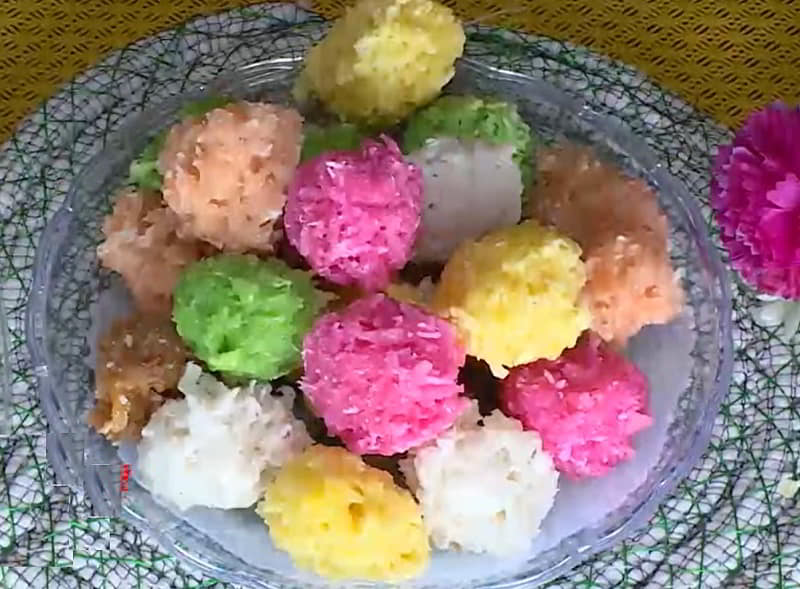
Geplak is a traditional Indonesian snack that is loved by locals and tourists alike. It is a sweet dish made from grated coconut mixed with palm sugar, resulting in a deliciously chewy and flavorful treat. To prepare geplak, fresh coconut is grated and mixed with melted palm sugar. The mixture is then shaped into small bite-sized pieces, often in the form of balls or rectangles. The coconut and palm sugar blend together harmoniously, creating a delightful combination of textures and tastes. Geplak is commonly enjoyed as a snack or dessert, perfect for satisfying those sweet cravings. Its rich coconut flavor pairs well with the subtle sweetness of palm sugar. The chewy texture adds a pleasant mouthfeel, making it a delightful treat to munch on. This traditional Indonesian snack can be found in various regions across the country, with each region adding its own unique twist to the recipe. Some variations include adding pandan leaves for a fragrant touch or incorporating other local ingredients for added flavor. Next time you visit Indonesia, be sure to try geplak and experience the wonderful blend of coconut and palm sugar that makes this snack so beloved by the locals.
Javanese Doughnut

The Javanese doughnut, known as Donat Jawa in Indonesian, is a cherished traditional snack in Javanese cuisine, particularly prominent in Central Java, Yogyakarta, and East Java, Indonesia. Unlike typical doughnuts made from potato or flour, this variant is crafted from cassava, offering a unique twist. Donat Jawa is favored for its savory flavor profile and is often enjoyed during various Javanese occasions, including wedding parties, wayang shows, ketoprak theater performances, and the holy month of Ramadan. Its popularity stems from its rich cultural heritage and its ability to bring people together during special gatherings and celebrations. Donat Jawa embodies the essence of Javanese culinary traditions, offering a delightful and distinctive treat enjoyed by locals and visitors alike.
Red Peach Cake
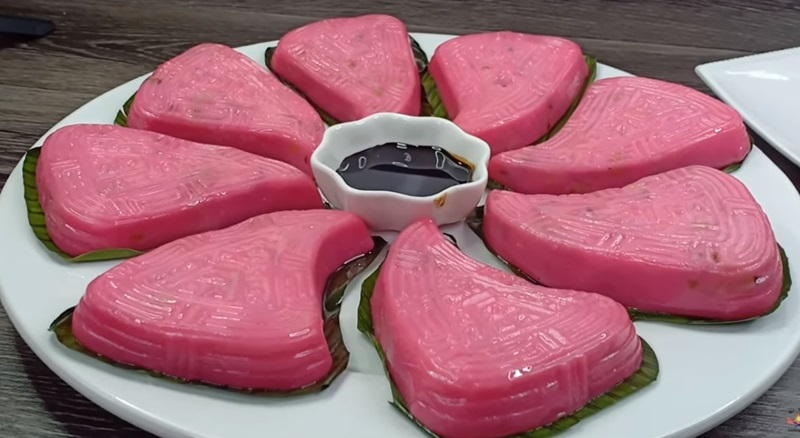
Red peach cake, also referred to as rice peach cake, stands out as a petite teardrop-shaped kuih, a stuffed dumpling popular in Indonesia. This delectable treat features a soft and sticky glutinous rice flour skin enveloping a flavorful filling comprising glutinous rice, peanuts, mushrooms, and shallots. The skin of the kuih is typically dyed in a delightful pink hue, and a wooden mold is used to shape it before the steaming process. The meticulous crafting of red peach cake reflects the culinary artistry and cultural heritage of the region. The combination of glutinous rice and a savory filling creates a harmonious blend of textures and flavors, making it a beloved delicacy. The vibrant pink color adds an appealing visual element, enhancing its allure. Whether enjoyed as a snack or a dessert, red peach cake exemplifies the culinary creativity embedded in the Chaoshan culinary repertoire.
Keripik Sanjai
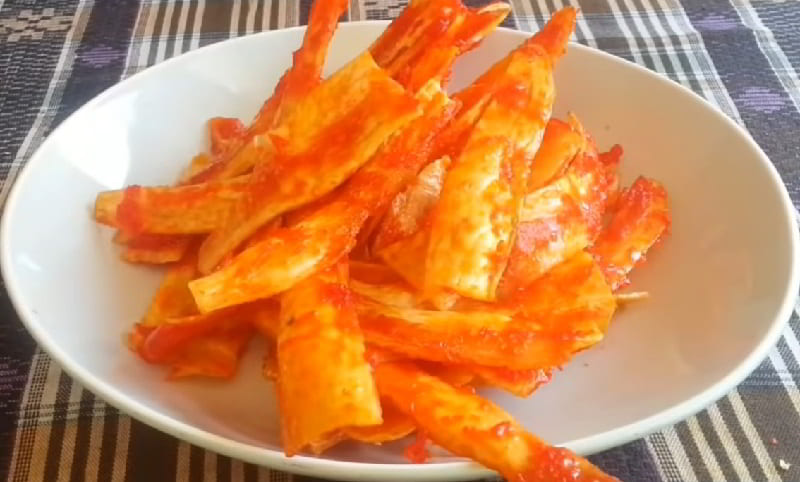
Keripik sanjai is a popular Indonesian snack food that is loved for its crispy and flavorful taste. Made from thinly sliced cassava or taro root, these chips are deep-fried until they become golden and crunchy. What sets keripik sanjai apart from other snack foods is the unique blend of spices used in its seasoning. Typically, the chips are coated with a combination of garlic, onion, chili, and other aromatic spices, giving them a savory and slightly spicy flavor. The seasoning is carefully balanced, allowing the natural taste of the cassava or taro root to shine through. Keripik sanjai is not only a delicious snack, but it is also a versatile one. It can be enjoyed on its own as a quick bite or served as a side dish alongside main meals. Some even use it as a topping for salads or soups, adding an extra layer of texture and flavor. Whether you're a fan of crispy snacks or looking to explore the diverse flavors of Indonesian cuisine, keripik sanjai is a must-try. Its addictive crunch and unique seasoning make it a delightful treat for snack enthusiasts of all ages.
Kue Bagea
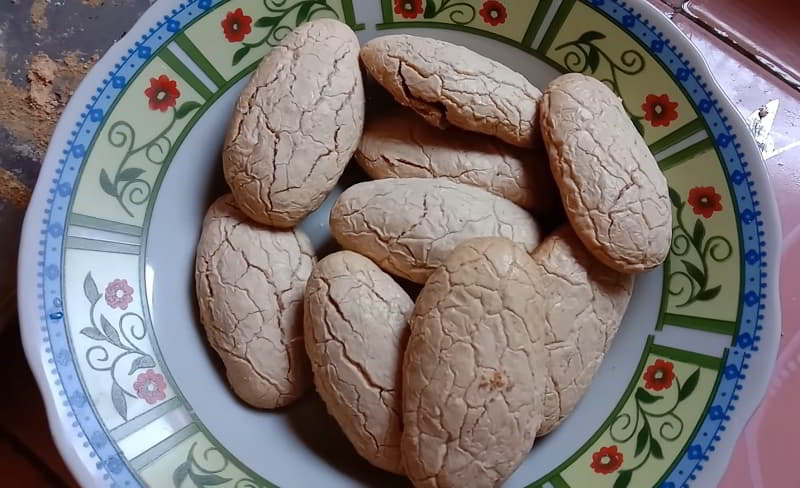
Kue bagea, also known as sago cake, is a cherished traditional Indonesian delicacy with a distinctive round shape and creamy color, setting it apart with unique attributes. At the heart of its preparation is the utilization of sago, a plant-based starch derived from the sago palm. The cultural significance of kue bagea is deeply embedded in the culinary traditions of Ternate, where it symbolizes local flavors and showcases artisanal expertise. The meticulous crafting and use of sago highlight the ingenuity inherent in Indonesian culinary practices. Whether savored as a delightful snack or indulged in as a sweet treat, kue bagea serves as a testament to the diversity and distinctiveness of desserts within the culinary tapestry of North Maluku. This confection adds to the rich array of Indonesian sweets, contributing to the nation's gastronomic heritage. The enduring popularity of kue bagea reflects its role not just as a culinary delight but as a cultural emblem, preserving traditions and celebrating the flavors unique to the region.
Kue Pinyaram
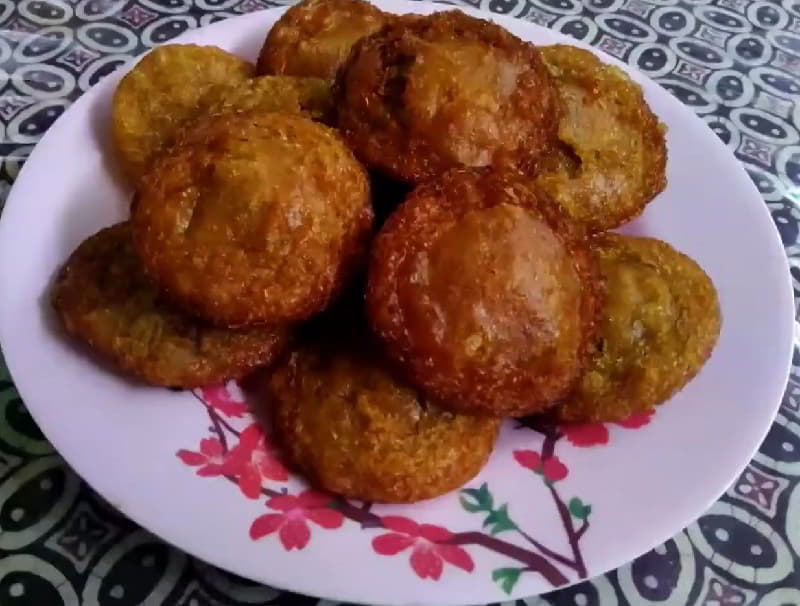
Kue Pinyaram stands as a cherished traditional Indonesian snack, often gracing special occasions such as wedding parties, Ramadan, and Eid al-Fitr. In contemporary times, Pinyaram has transcended its role as a delightful treat to become a notable souvenir representing Minangkabau culture. The ingredients that come together to create Pinyaram include a blend of white sugar or palm sugar, white rice flour, or the distinctive flavor of black rice, all harmoniously combined with coconut milk. The cooking process mirrors that of preparing pancakes, showcasing a familiar culinary technique. The cultural significance of Kue Pinyaram is deeply embedded in the fabric of Indonesian traditions, making it a sought-after delicacy during celebratory events. Its transformation into a symbolic souvenir of Minangkabau reflects the rich heritage associated with this flavorful snack. Whether enjoyed as a sweet addition to wedding festivities or embraced during the holy month of Ramadan, Pinyaram continues to captivate palates with its unique blend of ingredients and cultural resonance, contributing to the diverse tapestry of Indonesian culinary delights.
Es Goyang

Es Goyang is a beloved traditional Indonesian street food often found being sold by vendors along roadsides. Unlike conventional ice cream, it deviates from the use of cream or milk. Instead, its base comprises mung bean flour and corn flour, sweetened with sugar. Flavorings such as vanilla, chocolate, strawberry, or mung bean are commonly added to the mixture. The concoction is then boiled over a low flame while continuously stirred. Once boiled, it is poured into molds and placed in an ice bath or freezer, with a skewer inserted for stability. In traditional carts, shaking helps expedite the freezing process for even consistency. After solidifying, the dessert is dipped in melted chocolate and adorned with toppings like peanut chunks or sprinkles. Es Goyang offers a unique and refreshing treat cherished by Indonesians for its delightful flavors and textures.
Samosa
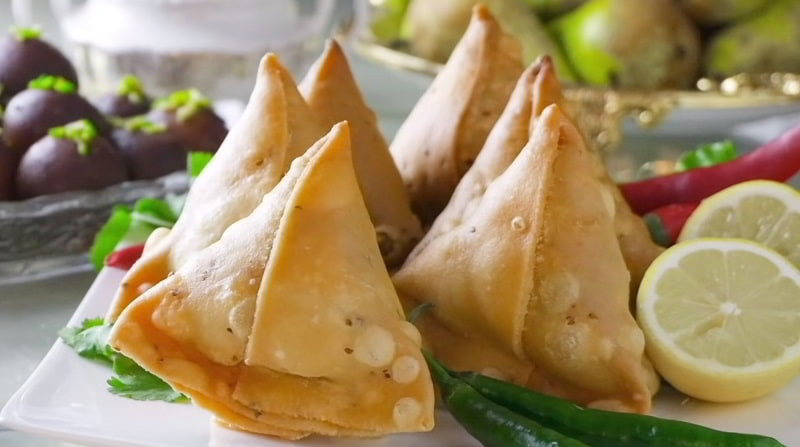
Samosa, a popular snack in Indonesia, is a delicious and savory dish that is loved by locals and visitors alike. This delectable treat is made of a crispy, golden-brown pastry filled with a mouthwatering mixture of potatoes, onions, peas, and various spices. The filling is typically cooked with a blend of garlic, ginger, cumin, coriander, and turmeric, giving it a fragrant and flavorful taste. The samosa is commonly shaped into a triangle, resembling a small, handheld pie. It is then deep-fried until it becomes crispy and crunchy on the outside while remaining soft and flavorful on the inside. This combination of textures adds to the overall appeal of the dish. Samosas can be enjoyed as a quick snack or as part of a meal. They are often served with a tangy and spicy dipping sauce, such as tamarind chutney or mint yogurt, which adds an extra burst of flavor. Whether enjoyed as a street food or at home, samosas are a delightful culinary experience that showcases the rich and diverse flavors of Indonesian cuisine.
Laddu
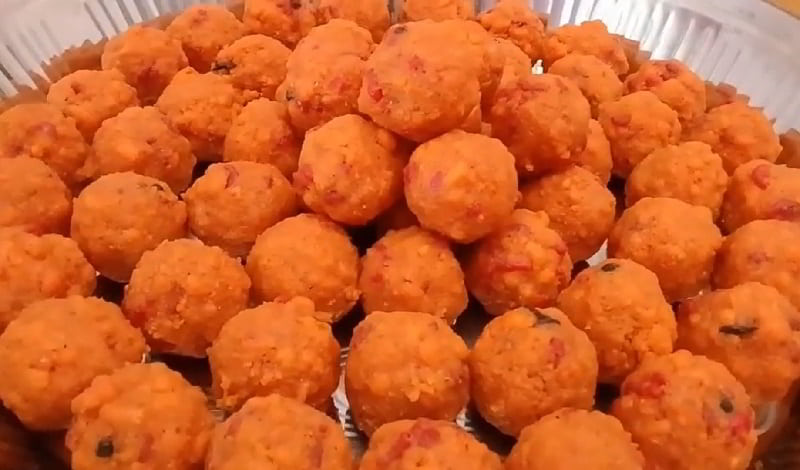
Laddu originates from India and has gained popularity in Indonesia as a delightful sweet snack. Comprising flour, sugar, ghee (clarified butter), nuts, raisins, and cardamom, laddu is a treat with a rich and diverse flavor profile. The preparation involves roasting flour in ghee until golden, then adding sugar and other flavorings. The resulting mixture is shaped into small round balls, left to cool, and transforms into a soft, melt-in-your-mouth texture that balances sweetness and savoriness. This delectable treat is savored during special occasions like weddings, festive celebrations, and religious ceremonies. Additionally, it's a favored companion to tea or coffee on regular days. Laddu's appeal extends to Indonesia, where it graces traditional markets, street food stalls, and even modern cafes and bakeries. Locals and tourists alike appreciate its unique taste and cultural significance, making laddu a cherished indulgence enjoyed across diverse occasions in both India and Indonesia.
Pastel de Nata

Pastel de nata is not actually an Indonesian snack food, but rather a traditional Portuguese pastry. Also known as Portuguese custard tart, it is a sweet and creamy treat that originated in Portugal. The pastry consists of a flaky, buttery crust filled with a rich and creamy egg custard. The custard is typically flavored with vanilla and has a slightly caramelized top. The crust of the pastel de nata is thin and crispy, providing a delightful contrast to the smooth and velvety custard filling. It is often sprinkled with cinnamon or powdered sugar for added flavor and a touch of sweetness. Pastel de nata is best enjoyed warm, straight out of the oven. The combination of the warm pastry and the creamy custard creates a heavenly taste sensation. It is a popular snack in Portugal and can be found in bakeries and cafes throughout the country. Although not originally from Indonesia, pastel de nata has gained popularity in recent years and can also be found in some Indonesian cafes and restaurants that offer international cuisine.
Idiyappam
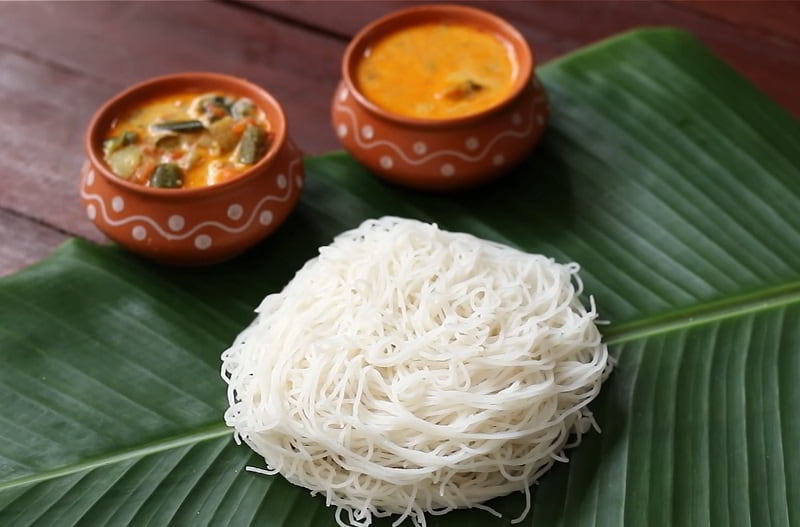
Idiyappam, known as putu mayang, is a cherished snack in Indonesia, celebrated for its delicate texture and adaptability. Crafted from rice flour, the process involves mixing the flour with water and salt to form a soft dough. This dough is then pressed through a specialized device, creating thin, vermicelli-like strands that are steamed to achieve a light and fluffy consistency. The versatility of Idiyappam shines as it can be relished on its own or paired with various accompaniments. Often served with coconut milk, it gains a creamy and slightly sweet undertone. Other popular pairings include spicy curries, chutneys, or a simple blend of grated coconut and sugar. Beyond being a favorite snack, Idiyappam is a household staple in Indonesia, gracing breakfast or dinner tables. Its customizable nature allows individuals to tailor it to their preferences, making it a beloved choice for both locals and tourists. Whether savored as a quick snack or part of a meal, Idiyappam consistently delights with its delicate texture and delicious flavors.
Modak
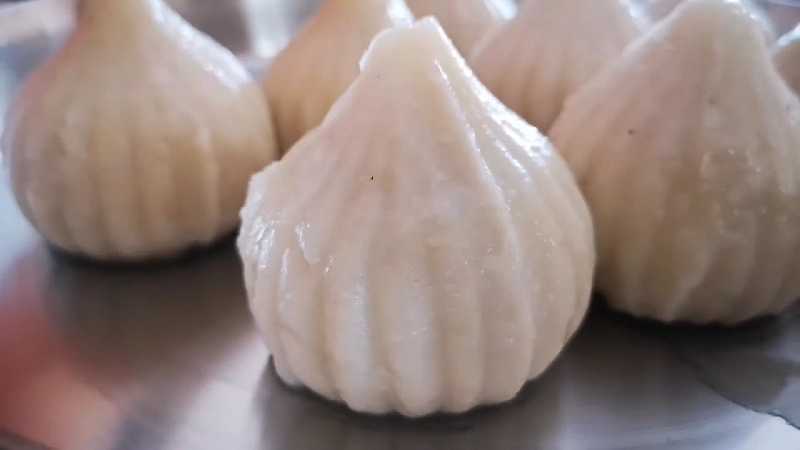
Modak, a cherished treat in Indonesia, is a distinctive dish made from a combination of rice flour and coconut filling. The dough is meticulously crafted by blending rice flour with water to achieve a smooth and pliable texture. The sweet and aromatic coconut filling is prepared by combining freshly grated coconut with palm sugar. The modak-making process involves rolling the dough into thin circles, placing a small amount of coconut filling in the center, and then folding and pinching the edges to create exquisite dumpling-like shapes. These creations are then steamed until they reach a soft and tender consistency. Typically served as a snack or dessert, modak pairs wonderfully with a cup of tea or coffee. The delightful taste experience arises from the interplay of the soft, chewy dough and the sweet, fragrant coconut filling. Beyond its deliciousness, modak boasts visual appeal, making it a favored choice for special occasions and celebrations throughout Indonesia. The unique combination of flavors and textures makes modak a delightful treat enjoyed across a variety of settings.
Tao kuih
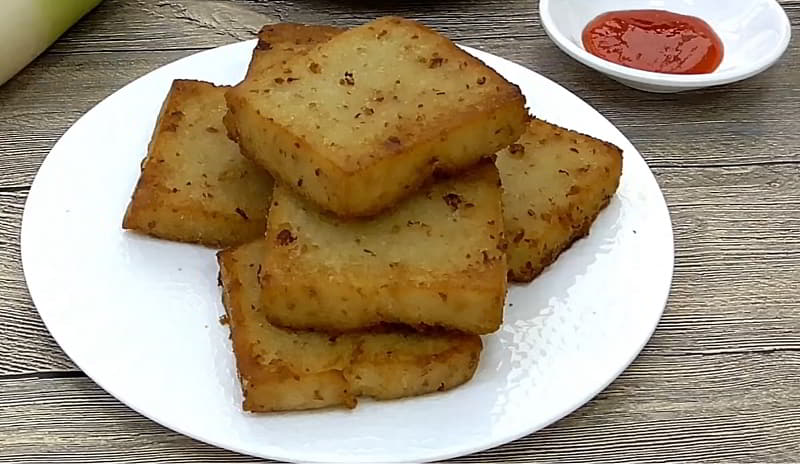
Hao kuih
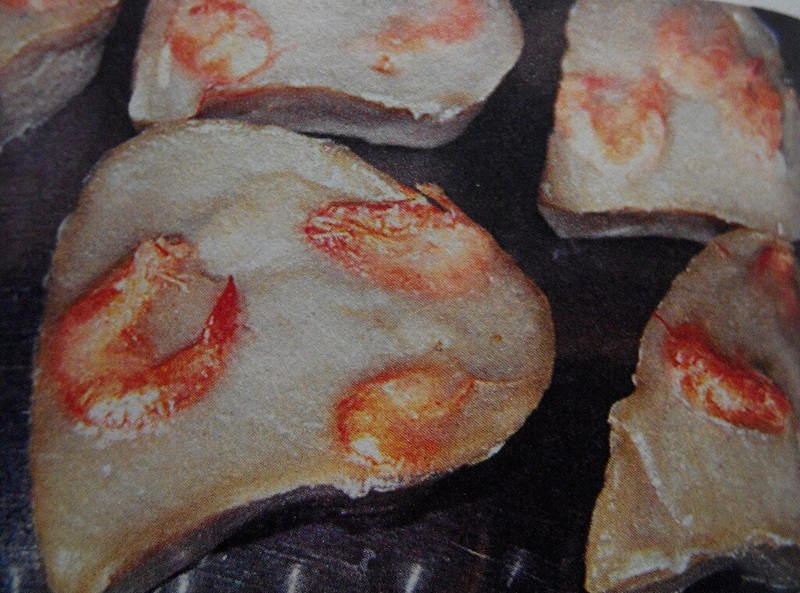
Getuk goreng
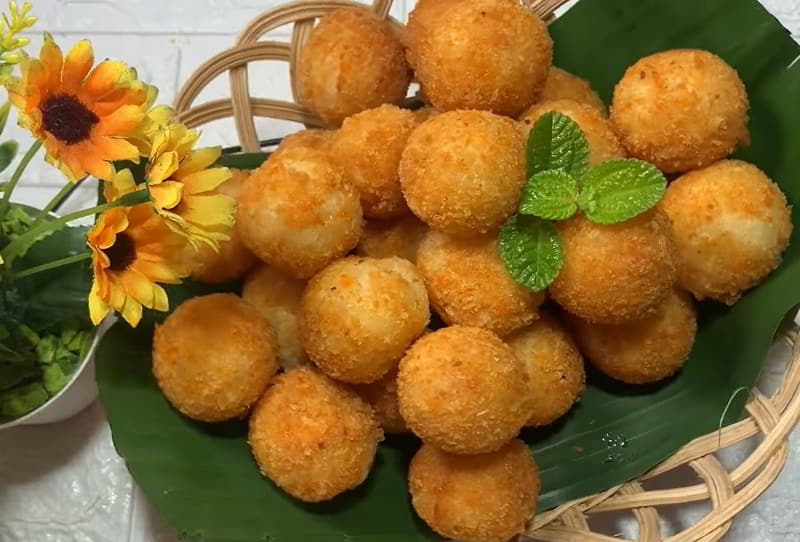





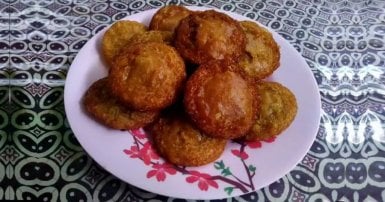
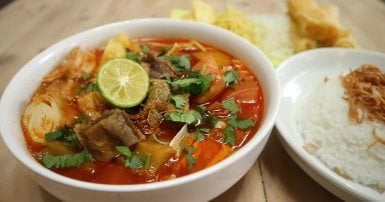
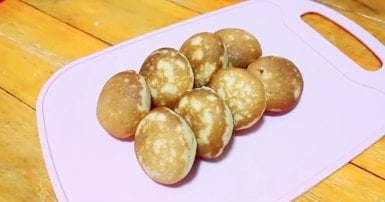
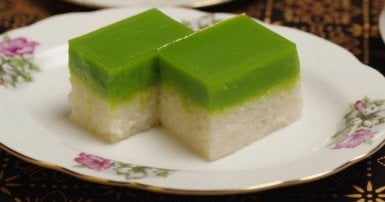
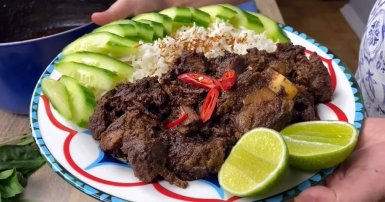
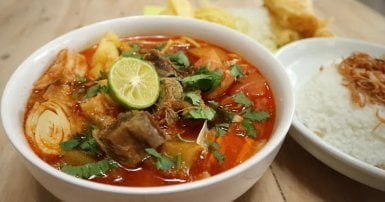
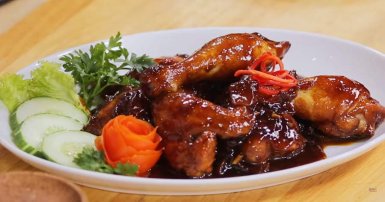

-1709813013.jpg)


